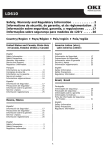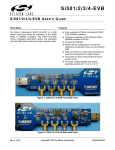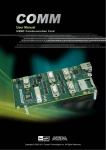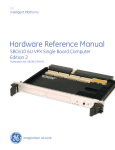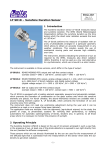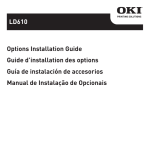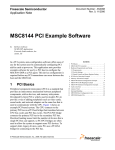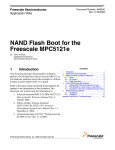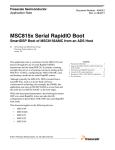Download MSC8144AMC-S Advanced Mezzanine Card User Manual
Transcript
MSC8144AMC-S Advanced Mezzanine Card User Manual MSC8144AMCSUM Rev. 1 06/2008 How to Reach Us: Home Page: www.freescale.com Web Support: http://www.freescale.com/support USA/Europe or Locations Not Listed: Freescale Semiconductor, Inc. Technical Information Center, EL516 2100 East Elliot Road Tempe, Arizona 85284 +1-800-521-6274 or +1-480-768-2130 www.freescale.com/support Europe, Middle East, and Africa: Freescale Halbleiter Deutschland GmbH Technical Information Center Schatzbogen 7 81829 Muenchen, Germany +44 1296 380 456 (English) +46 8 52200080 (English) +49 89 92103 559 (German) +33 1 69 35 48 48 (French) www.freescale.com/support Information in this document is provided solely to enable system and software implementers to use Freescale Semiconductor products. There are no express or implied copyright licenses granted hereunder to design or fabricate any integrated circuits or integrated circuits based on the information in this document. Freescale Semiconductor reserves the right to make changes without further notice to any products herein. Freescale Semiconductor makes no warranty, representation or guarantee regarding the suitability of its products for any particular purpose, nor does Freescale Semiconductor assume any liability arising out of the application or use of any product or circuit, and specifically disclaims any and all liability, including without limitation consequential or incidental damages. “Typical” parameters which may be provided in Freescale Semiconductor data sheets and/or specifications can and do vary in different applications and actual performance may vary over time. All operating parameters, including “Typicals” must be validated for each customer application by customer’s technical experts. Freescale Semiconductor does not convey any license under its patent rights nor the rights of others. Freescale Semiconductor products are not designed, intended, or authorized for use as components in systems intended for Japan: Freescale Semiconductor Japan Ltd. Headquarters ARCO Tower 15F 1-8-1, Shimo-Meguro, Meguro-ku Tokyo 153-0064 Japan 0120 191014 or +81 3 5437 9125 [email protected] surgical implant into the body, or other applications intended to support or sustain life, Asia/Pacific: Freescale Semiconductor China Ltd. Exchange Building 23F No. 118 Jianguo Road Chaoyang District Beijing 100022 China +86 010 5879 8000 [email protected] unintended or unauthorized use, even if such claim alleges that Freescale For Literature Requests Only: Freescale Semiconductor Literature Distribution Center P.O. Box 5405 Denver, Colorado 80217 +1-800 441-2447 or +1-303-675-2140 Fax: +1-303-675-2150 LDCForFreescaleSemiconductor @hibbertgroup.com Document Number: MSC8144AMCSUM Rev. 1, 06/2008 or for any other application in which the failure of the Freescale Semiconductor product could create a situation where personal injury or death may occur. Should Buyer purchase or use Freescale Semiconductor products for any such unintended or unauthorized application, Buyer shall indemnify and hold Freescale Semiconductor and its officers, employees, subsidiaries, affiliates, and distributors harmless against all claims, costs, damages, and expenses, and reasonable attorney fees arising out of, directly or indirectly, any claim of personal injury or death associated with such Semiconductor was negligent regarding the design or manufacture of the part. Freescale™, the Freescale logo, QUICC Engine, StarCore, ColdFire, and CodeWarrior are trademarks or registered trademarks of Freescale Semiconductor, Inc. in the U.S. and other countries. RapidIO is a registered trademark of the RapidIO Trade Association. All other product or service names are the property of their respective owners. © Freescale Semiconductor, Inc., 2008. All rights reserved. Contents Paragraph Number Title Page Number Chapter 1 General Information 1.1 1.2 1.2.1 1.2.2 1.3 1.3.1 1.3.2 1.4 1.5 1.6 1.7 Introduction...................................................................................................................... 1-1 Working Configurations................................................................................................... 1-2 System Development Environment ............................................................................. 1-2 Standalone Operation................................................................................................... 1-2 MSC8144AMC-S Processor Board ................................................................................. 1-2 MSC8144AMC-S Features.......................................................................................... 1-2 External Connectors..................................................................................................... 1-4 MSC8144AMC-S Block Diagram................................................................................... 1-5 Definitions, Acronyms, and Abbreviations ..................................................................... 1-6 Related Documentation.................................................................................................... 1-6 Specifications................................................................................................................... 1-7 Chapter 2 Hardware Preparation and Installation 2.1 2.2 Unpacking Instructions .................................................................................................... 2-1 Installation Instructions.................................................................................................... 2-2 Chapter 3 Memory Map Chapter 4 Controls and Indicators 4.1 4.2 4.3 4.4 DIP Switches.................................................................................................................... 4-2 Jumpers ............................................................................................................................ 4-3 LEDs ................................................................................................................................ 4-3 Push Buttons .................................................................................................................... 4-4 Chapter 5 MSC8144AMC-S Functional Description 5.1 5.1.1 5.1.1.1 5.1.1.2 5.1.2 5.1.3 MSC8144 Digital Signal Processing Block..................................................................... 5-1 MSC8144 DDR2 Memory........................................................................................... 5-2 DDR Groups ............................................................................................................ 5-3 Terminations and I/O Voltage .................................................................................. 5-3 MSC8144 Serial RapidIO Interface............................................................................. 5-4 MSC8144 Ethernet Interface ....................................................................................... 5-5 MSC8144AMC-S Advanced Mezzanine Card User Manual, Rev. 1 Freescale Semiconductor iii Contents Paragraph Number 5.1.3.1 5.1.3.2 5.1.4 5.1.5 5.1.6 5.1.7 5.1.7.1 5.1.7.2 5.1.7.3 5.1.8 5.1.9 5.2 5.2.1 5.2.2 5.3 5.3.1 5.3.2 5.3.3 5.3.4 5.3.5 5.4 5.5 5.5.1 5.5.1.1 5.5.2 5.6 5.6.1 5.6.2 5.7 5.7.1 5.7.2 5.7.2.1 5.7.2.2 5.7.2.3 5.7.2.4 5.7.2.5 5.7.2.6 5.7.2.7 5.7.2.8 5.7.2.9 5.7.2.10 Title Page Number Ethernet Connections............................................................................................... 5-5 Ethernet Initialization .............................................................................................. 5-6 MSC8144 TDM Interface............................................................................................ 5-7 MSC8144 UART Interface .......................................................................................... 5-9 MSC8144 JTAG Interface ........................................................................................ 5-10 Reset Configuration ................................................................................................... 5-11 Loading Reset Configuration Word from External I2C......................................... 5-12 Loading Reset Configuration Word from External Signals................................... 5-14 MSC8144 Clocking ............................................................................................... 5-16 GPIO/IRQ Distribution.............................................................................................. 5-17 SPI Interface .............................................................................................................. 5-18 MSC8144 to Backplane Serial RapidIO Connectivity .................................................. 5-18 Tundra TSI578 Serial RapidIO Switch...................................................................... 5-18 I2C Interface .............................................................................................................. 5-19 MSC8144 to Backplane Ethernet Connectivity............................................................. 5-20 Marvell 88E6185 Ethernet Switch............................................................................. 5-20 Marvell 88E6185 Ethernet Switch Configuration ..................................................... 5-20 Marvell 88E1145 Quad PHY..................................................................................... 5-21 Marvell 88E1145 Configuration ................................................................................ 5-21 Marvell 88E1111 Ethernet PHY Configuration......................................................... 5-22 Backplane Connector ..................................................................................................... 5-23 General Board Configuration......................................................................................... 5-26 Reset Operation and Connectivity ............................................................................ 5-26 Reset Control ......................................................................................................... 5-27 System CPLD ............................................................................................................ 5-28 Power Supply ................................................................................................................. 5-29 Power Requirements .................................................................................................. 5-29 Power Supply Operation............................................................................................ 5-30 Module Management Controller (MMC) ...................................................................... 5-32 MMC Implementation ............................................................................................... 5-33 MMC Operation Overview........................................................................................ 5-34 Module Insertion.................................................................................................... 5-34 Enabling the MMC ................................................................................................ 5-34 Status LEDs ........................................................................................................... 5-35 Hot Swap Switch ................................................................................................... 5-35 Module Management Communications Bus (IPMB-L) ........................................ 5-36 Geographical Address (GA[2:0]) .......................................................................... 5-36 Module temperature Sensors ................................................................................. 5-36 Module Voltage Sensors ........................................................................................ 5-36 MMC UART.......................................................................................................... 5-36 BDM Debug Header .............................................................................................. 5-36 MSC8144AMC-S Advanced Mezzanine Card User Manual, Rev. 1 iv Freescale Semiconductor Contents Paragraph Number 5.7.2.11 5.7.3 5.7.3.1 5.7.3.1.1 5.7.3.1.2 5.7.3.2 5.7.3.3 5.8 5.9 Title Page Number Persistent Store ...................................................................................................... 5-36 MMC User Operation ................................................................................................ 5-37 Hot-Swapping ........................................................................................................ 5-37 Hot-Swapping a Board In .................................................................................. 5-37 Hot-Swapping a Board Out ............................................................................... 5-37 UART Terminal ..................................................................................................... 5-38 FRU records........................................................................................................... 5-38 Boundary SCAN Testing ............................................................................................... 5-42 Thermal Requirements................................................................................................... 5-42 Chapter 6 Revision History MSC8144AMC-S Advanced Mezzanine Card User Manual, Rev. 1 Freescale Semiconductor v Contents Paragraph Number Title Page Number MSC8144AMC-S Advanced Mezzanine Card User Manual, Rev. 1 vi Freescale Semiconductor Chapter 1 General Information 1.1 Introduction This document describes the MSC8144AMC-S AdvancedMC (AMC) Card. The MSC8144AMC-S provides an AMC debugging environment for engineers developing applications for the MSC8144 series of Freescale Processors. The MSC8144 is a highly integrated DSP processor that contains four StarCore® SC3400 DSP subsystems, 512 Kbytes of M2 shared memory, 10 Mbytes of M3 shared memory, L1 instruction and data caches, 128 Kbytes of shared L2 instruction cache, a DDR memory controller, a serial RapidIO® interface, two 10/100/1000Base-T Ethernet Controllers, an ATM Controller Supporting various ATM adaptation layers, eight 512-channel time division multiplexing (TDM) interfaces, a 16-channel DMA Controller, 32-bit PCI interfaces, UART interface and an I2C interface. The MSC8144AMC-S single-width AMC board is designed around four Freescale MSC8144s. Each MSC8144 has 256 Mbytes of associated 32-bit-wide DDR2. High throughput serial RapidIO links connect the four MSC8144s to each other and to the data backplane. The serial RapidIO interfaces can run in x1 or x4 mode and are interconnected via a TSI578 serial RapidIO switch. For the control plane, each MSC8144 RGMII Gigabyte Ethernet port is linked to the backplane ports via an Ethernet switch. The 32 TDM lines (16 Rx and 16 Tx) are routed to the backplane from each MSC8144. All TDM Modules, with two links per module, are connected together over a common bus to achieve the 32 TDM line requirements. This TDM linkage to the backplane is optional and can be isolated when not required. For bootstrap purposes, a common serial I2C bus and EEPROMs are connected between the MSC8144s. The EEPROM is programmed through a master MSC8144 or an in-circuit programmer attached to a header. AMC board management is handled via a CorEdge enabled Module Management Controller based around a Freescale MCF5213. The provides the board with power sequencing, hot swap functionality, temperature sensing and FRU record storage. Due to space restrictions on the PCB, a number of debug and programming headers are offloaded to an expansion card via the front panel. MSC8144AMC-S Advanced Mezzanine Card User Manual, Rev. 1 Freescale Semiconductor 1-1 General Information 1.2 Working Configurations There are two configurations for use of the MSC8144AMC-S board: system development environment or standalone. 1.2.1 System Development Environment Freescale recommends that the AMC be run using an ATCA, µTCA, picoTCA chassis, or equivalent. This delivers the correct power and air flow to the board. I nsert the board into the carrier chassis as defined by the specific carrier instructions. As in standard development systems, these chassis provide direct connections to the JTAG debugger and external connections. 1.2.2 Standalone Operation An external keyed power supply connector is provided for standalone operation. When using a standalone board, you must ensure that adequate cooling is provided for the board. Remove the front panel to access the connector. 1.3 MSC8144AMC-S Processor Board The following subsystems provide a detailed description of the board and its connectors. 1.3.1 • • • MSC8144AMC-S Features Target use — System component for baseband, media gateway, and RNC systems — Software development platform for baseband, media gateway, and RNC solutions — Design reference and enablement platform for customers and third parties Form factor. Single-width AMC size, full height Module Connectivity — Two serial RapidIO x4 interfaces from backplane ports 4–7 and 8–11 routed to DSP farm via a serial RapidIO switch — 1000 Base-X Gigabit Ethernet from backplane ports 0 and 1 routed to DSP farm via Ethernet switch — Gigabit Ethernet routed to front plane expansion connector via a switch — E1/T1 TDM connection consisting of 8x (TX + RX) and common clock and sync on an AMC connector — Each MSC8144 UART interface is multiplexed via the CPLD to a single RS-232 connector on the expansion connector — I2C Bus connecting MSC8144s for boot and configuration MSC8144AMC-S Advanced Mezzanine Card User Manual, Rev. 1 1-2 Freescale Semiconductor General Information • • • • • Hardware Blocks — Four MSC8144 DSPs (four cores per device), each with the following: – x4 serial RapidIO interface routed to a serial RapidIO switch – RGMII interface routed to an Ethernet switch – TDM routed to a CPLD for multiplexing to the backplane – I2C interface for boot – 256 Mbytes of 32-bit DDR2 memory — Tundra TSI578 serial RapidIO switch – 4 lanes of x4 serial RapidIO lines from the MSC8144 farm – 2 lanes of x4 serial RapidIO lines to ports 4–7 and 8–11 of the backplane – 2 lanes of x4 serial RapidIO lines to ports 12–15 and 17–20 of the backplane – Controlled via I2C or master MSC8144 — Ethernet switch – 4 lanes of RGMII from the MSC8144 farm – 2 lanes of 1000Base-X to ports 0 and 1 of the backplane – 1 lane of SGMII to the front panel expansion connector — TDM. MSC8144 TDM routed to backplanes ports 12–15 and 17–20 (multiplexed with the serial RapidIO lines) — UART. MSC8144 UARTs multiplexed to the expansion connector Boot. Boot mode defined by switch: — Serial RapidIO interface via the backplane — From the on-board I2C MSC8144 Debug. Chained JTAG header for four MSC8144s Board Management — Hot Swapping — FRU Storage — Status LEDs — Temperature and voltage monitoring Power Supply — 12 V and 3.3 V IPMCV, provided from AMC edge connector or terminal connector — On board voltage requirements are generated via DC-DC voltage regulators: – 3.3 V for I/O – 1.0 V for the MSC8144 cores and PLLs – 2.5 V for M3 memory – 1.25 V for MSC8144 M3 memories and the TSI578 core – 1.8 V/0.9 V DDR2 – 1.2 V, 1.5 V, and 2.5 V for the Ethernet switches MSC8144AMC-S Advanced Mezzanine Card User Manual, Rev. 1 Freescale Semiconductor 1-3 General Information 1.3.2 External Connectors The MSC8144AMC-S interconnects with external devices via the following set of connectors (see Figure 1-1 and Figure 1-2): • AMC connector for connecting to ATCA and µTCA backplanes (P1) • MSC8144 OnCE 14-pin Debug connector (HD2) • CPLD programming header, 10 pin (HD1) • Standalone power connector (P2) • Expansion connector (J1) giving access to the following: — MSC8144 UART — Front panel Ethernet RJ45 — Ethernet Switch EEPROM programming header — ColdFire® (MMC) BDM — ColdFire (MMC)UART — External I2C EEPROM programming header J1:Expansion Connector P1:AMC Connector P2:External Power HD1: CPLD Programming Header (remove Front panel for access) HD2:MSC8144 JTAG Header Figure 1-1. MSC8144AMC-S Board External Connections MSC8144AMC-S Advanced Mezzanine Card User Manual, Rev. 1 1-4 Freescale Semiconductor General Information Figure 1-2. MSC8144AMC-S Expansion Card External Connections 1.4 MSC8144AMC-S Block Diagram Expansion Connector I2C header DDR II CPLD JTAG 32-bit MSC8144 DDR Eth. EPROM Ethernet Switch GigE RapidIO sRIO AMC Port 0 TDM DDR II Port 1 32-bit MSC8144 DDR GigE RapidIO sRIO DDR II TDM 32-bit DDR GigE RapidIO sRIO TDM x4 RapidIO Switch MSC8144 Port 4:7 x4 x4 x4 x4 x4 Port 8:11 x4 Port 12:15 Port 17:20 x4 DDR II MMC 32-bit MSC8144 DDR TDM Buffer GigE RapidIO sRIO TDM Reset/Control CPLD Control MMC Figure 1-3. MSC8144AMC-S Block Diagram MSC8144AMC-S Advanced Mezzanine Card User Manual, Rev. 1 Freescale Semiconductor 1-5 General Information 1.5 Definitions, Acronyms, and Abbreviations Table 1-1. Definitions, Acronyms, and Abbreviations Acronym Definition AMC Advanced Mezzanine Card ATCA Advanced Telecommunications Computing Platform BDM Background Debug Mode CPLD Complex Programmable Logic device DIP Dual In Line Package DNP Do Not Populate DSP Digital Signal Processor EEPROM Electrically Erasable, Programmable Read Only Module GETH Giga-bit Ethernet HW Hardware I2C(bus) inter-IC bus RCW Reset Configuration Word UART Universal Asynchronous Receiver/Transmitter UEC UCC Gigabit Ethernet Controller uTCA micro Telecommunications Computing Platform 1.6 Related Documentation This document references the following documents: • MSC8144AMC-S Getting Started Guide • MSC8144 Reference Manual • MSC8144 Data Sheet • PICMG AMC.0 R2.0 “Advanced Mezzanine Card Base Specification” • PICMG 2.15 “PCI Telecom Mezzanine/Carrier card Specification” MSC8144AMC-S Advanced Mezzanine Card User Manual, Rev. 1 1-6 Freescale Semiconductor General Information 1.7 Specifications Table 1-2 specifies the board physical characteristics. Table 1-3 specifies the DSP processing support. Table 1-2. MSC8144AMC-S Board Characteristics Power Requirements Operating temperature Storage Temperature Relative humidity Dimensions Specifications No external power supply for AMC modes- powered from ATCA Carrier / uTCA Chassis In standalone mode, the recommended PSU should supply 12 V at 5 A, and 3.3 V at 150 mA 0° C to 70° C –25° C to 85° C 5% to 90% (non condensing) Single width AMC form factor Length = 180.6 mm Width: 73.5 mm Thickness: 1.6 mm Table 1-3. Processing Support Subsystem MSC8144 DSPs Memory Communication Ports Component Cores per DSP Internal M2, M3 External DDR I2C EEPROM Gigabit Ethernet Serial RapidIO Interface TDM UART Specifications 4 cores each running at 1 GHz Total 10.96 Mbytes 256 Mbytes of 32-bit wide DDR2-400 64-Kbyte serial EEPROM for Boot Code RGMII GigE DSP to switch SerDes from switch to backplane/frontplane x1/x4 serial RapidIO protocols. Hardware-configurable to 1.25 GHz, 2.5 GHz, and 3.125 GHz data rates Eight TDM ports shared between DSPs and routed to the backplane via optional DNP resistors RS-232 transceiver allows data exchange at 115 Kbps MSC8144AMC-S Advanced Mezzanine Card User Manual, Rev. 1 Freescale Semiconductor 1-7 General Information MSC8144AMC-S Advanced Mezzanine Card User Manual, Rev. 1 1-8 Freescale Semiconductor Chapter 2 Hardware Preparation and Installation This chapter provides unpacking instructions, hardware preparation, and installation instructions for the MSC8144AMC-S Processor Board. For details on hardware preparation, see the MSC8144AMC-S Hardware Getting Started Guide (MSC8144AMCSHWGSG). 2.1 Unpacking Instructions NOTE If the shipping carton is damaged upon receipt, request that the carrier agent to be present during unpacking and inspection of equipment. CAUTION Avoid touching areas of integrated circuitry; static discharge can damage circuits. • • • Unpack equipment from shipping carton Refer to packing list and verify that all items are present Save packing material for storing and reshipping of equipment MSC8144AMC-S Advanced Mezzanine Card User Manual, Rev. 1 Freescale Semiconductor 2-1 Hardware Preparation and Installation 2.2 Installation Instructions Perform the following steps in the order listed to install the MSC8144AMC-S Processor Board properly. 1. Verify that jumpers and switches are in their default positions (See Chapter 4, "Controls and Indicators," for a list of default positions). 2. Connect external cables in accordance with your needs (See Section 1.3.2, "External Connections," for more details). 3. Insert the board into the carrier/chassis as per the specific chassis operating instructions. 4. Switch on the power to the chassis. 5. Check for completion of the reset sequence indicated by the LEDs; see Figure 4-1 for locations. A full description of the LEDs is given in Table 4-3. 6. When powered up, verify that the 12 V (LD601) and 3.3 V (LD602) LEDs illuminate and stay lit. This indicates the board power is applied. 7. Check for completion of the reset sequence by verifying the following LEDs: a) Verify the DSP PORESET (LD609) and PORESET (LD612) LEDs illuminate and then turn off to indicate that the MSC8144 reset sequence is complete. b) The four MSC8144 RGMII Activity LEDs (LD610, LD606, LD607, LD608) illuminate and then turn off. 8. Ethernet port activity LEDs (LD614, LD615) indicate any Ethernet link to the backplane (system-dependent). 9. Pressing the front panel reset button SW1 power-cycles the board and starts the reset sequence. 10. Pressing the reset button SW2 resets the board and starts the reset sequence 11. Operate the CodeWarrior IDE software to verify that the board is installed properly MSC8144AMC-S Advanced Mezzanine Card User Manual, Rev. 1 2-2 Freescale Semiconductor Chapter 3 Memory Map Each of the four MSC8144s has an identical memory map as described in Table 3-1. Table 3-1. MSC8144 Memory Map Address Range Memory Type 0x40000000−0x4FFFFFFF 0x50000000−0xBFFFFFFF External DDR2 0xC0000000−0xC007FFFF M2 Shared — 0xC0080000−0xC007FFFF 0xD0000000−0xD09FFFFF 0xD0A00000−0xDFFFFFFF M3 memory 0xE0000000−E7FFFFFFF PCI Port 0xE8000000−0xFEDFFFF Device Name Size 2x 16-bit wide MT47H64M16HR Empty space 256 Mbytes 1.5 Gbytes Internal 512 Kbytes — Empty space 255.5 Mbytes — Internal Empty space 10 Mbytes 1 Gbyte Internal (PCI not used) 128 Mbytes — Empty space 366 Mbytes 256 Kbytes 768 Kbytes 0xFEE00000−0xFEE3FFF 0xFEE40000−0xFEEFFFF QUICC Engine subsystem — Internal Empty Space 0xFEF00000−0xFEF17FFF Boot ROM Internal 96 Kbytes Empty Space 928 Kbytes 0xFEF18000−0xFFFFFFFF — MSC8144AMC-S Advanced Mezzanine Card User Manual, Rev. 1 Freescale Semiconductor 3-1 Memory Map MSC8144AMC-S Advanced Mezzanine Card User Manual, Rev. 1 3-2 Freescale Semiconductor Chapter 4 Controls and Indicators This chapter describes the controls and indicators for the MSC8144AMC-S processor board, which includes switches, jumpers, LEDs, and push button switches shown in Figure 4-1. LD603: Blue MMC LED Reset Button (power recycle) AMC Handle LD5 Red MMC LED Configuration Switches 4321 SW3 OFF ON 4321 OFF ON SW4 J2:Jumper SW2 [reset] LD611: DSP2 User Programmable LD613: DSP4 User Programmable Ethernet Switch •LD614: AMC Port 1 Activity •LD615: AMC Port 0 Activity •LD612: HRESET •LD609: PORESET RGMII Activity LD605: Ethernet Front Panel Activity •LD608: DSP4 •LD607: DSP3 LD610; DSP1 •LD606: DSP2 LD603: MMC Blue LED •LD602 3.3V •LD601: Power Good LD600: DSP1 User Programmable LD604; DSP3 User Programmable Figure 4-1. MSC8144AMC-S Switches, Jumpers, LEDs, and Push Buttons Locations MSC8144AMC-S Advanced Mezzanine Card User Manual, Rev. 1 Freescale Semiconductor 4-1 Controls and Indicators 4.1 DIP Switches Figure 4-1 shows the location on the board of the DIP switches in their default position. Figure 4-2 describes the possible settings of the switches. Note that when ON, the value of the switch is zero. For a detailed description of the bits and fields see the MSC8144 Reference Manual. Check the default positions and make sure that the board is operational before changing any settings. SW3 Configuration SP_IO1 RST_MMC - ON 1 2 3 4 SP_IO0 0Å 1Å OFF ON ON SW4 Configuration UART1 RCW_SRC DBG ON 1 2 3 4 UART0 0Å 1Å ON ON ON SW3.1-SW3.2 SP_IO_SPEED[0:1]: Select TSI578 SRIO Speed 00 = 1.25 GHz 01 = 3.125 GHz [Default] 10 = 2.5 GHz 11 = illegal SW3.3 0 = Reset CPLD controlled Power Up [default] 1 = ColdFire device-controlled MMC SW4.4 Future use SW4.1-SW4.2 Select MSC8144 UART output 00 = DSP1 [default] 01 = DSP2 10 = DSP3 11 = DSP4 SW4.3 0 = RCW Source from I2C pins/Boot Port = Serial RapidIO interface[default] 1 = RCW Source from External pins /Boot Port = I2C SW4.4 0 = MSC8144 does not enter Debug Mode but operates normally [default] 1 = MSC8144 enters Debug Mode after reset, see MSC8144 Reference Manual for details. Figure 4-2. DIP Switch Settings Table 4-1. MSC8144AMC-S Clock Values Ref Clock SW4.3 = ON SW4.3 = OFF CLKIN Cores System Clock M3 DDR QUICC Engine Serial RapidIO 66 MHz 1 GHz 400 MHz 400 MHz 400 MHz 400 MHz 3.125 GHz 66 MHz 800 MHz 400 MHz 400 MHz 400 MHz 400 MHz 1.25 GHz MSC8144AMC-S Advanced Mezzanine Card User Manual, Rev. 1 4-2 Freescale Semiconductor Controls and Indicators 4.2 Jumpers There is one jumper on the board, described in Table 4-2, that is used to configure the CPLD JTAG chain. Table 4-2. Jumper Position Jumper J2 4.3 Description Selects the Reset and System JTAG Chain • When in position 1-2 the Reset CPLD only is in the chain • When in position 2-3 both the Reset and System CPLDs are in the chain Note: If the reset CPLD is blank then use position 1-2 to program the Reset CPLD LEDs Table 4-3 describes the LED functions and Figure 4-1 shows the LED location on the MSC8144AMC-S Processor Board. Table 4-3. LED Descriptions No. Description LD601 Power Good LD602 3.3 V (IPMCV) present LD609 PORESET LD612 HRESET LD600 DSP1 User Programmable LD611 DSP2 User Programmable LD604 DSP3 User Programmable LD613 DSP4 User Programmable LD610 DSP1 RGMII Activity LD606 DSP2 RGMII Activity LD607 DSP3 RGMII Activity LD608 DSP4 RGMII Activity LD605 Front Panel Ethernet Activity LD615 AMC Port 0 Ethernet Activity LD614 AMC Port 1 Ethernet activity LD603 MMC Blue LED (Hot swap) LD5 MMC Red LED (Status (*) Critical Indicator Color Green Yellow Green Yellow Yellow Yellow Yellow Yellow Yellow Yellow Yellow Yellow Yellow Yellow Yellow Blue Red LED On Power good IPMCV power on PORESET asserted HRESET asserted User programmable User programmable User programmable User programmable Ethernet activity Ethernet activity Ethernet activity Ethernet activity Ethernet activity Ethernet activity Ethernet activity Hot swap mode Fault condition LED Off Power supply fail(*) IPMCV power off PORESET de-asserted HRESET de-asserted User programmable User programmable User programmable User programmable No Ethernet activity No Ethernet activity No Ethernet activity No Ethernet activity No Ethernet activity No Ethernet activity No Ethernet activity Non-hot-swap mode Normal operation. MSC8144AMC-S Advanced Mezzanine Card User Manual, Rev. 1 Freescale Semiconductor 4-3 Controls and Indicators 4.4 Push Buttons Figure 4-3 describes the MSC8144AMC-S Processor Board push buttons. SW1 Power Cycle Pressing button SW1 on the front panel recycles the board power (Restarts the power sequencing on the board.) SW2 Hard Reset Pressing button SW2 on the back of the board causes a Power On Reset to all Components. Figure 4-3. MSC8144AMC-S Push button Switches MSC8144AMC-S Advanced Mezzanine Card User Manual, Rev. 1 4-4 Freescale Semiconductor Chapter 5 MSC8144AMC-S Functional Description This chapter describes the design details of the various MSC8144AMC-S hardware blocks. The hardware description has been partitioned into the following logical sections: • MSC8144 Digital Signal Processing Block • MSC8144 to Backplane SRIO Connectivity • MSC8144 to Backplane Ethernet Connectivity • Board Control (Power, Reset, Clock, JTAG and others) The MSC8144AMC-S is designed to comply with the PICMG AMC.0 R2.0 specification with AMC.4 (serial RapidIO interface), fitting into a single-width, full height mezzanine card. The card contains four MSC8144 devices with associated DDR2 memory. Each MSC8144 has gigabit Ethernet connectivity to the AMC backplane via an Ethernet switch. There is serial RapidIO connectivity to the backplane via a serial RapidIO switch. In addition, 32 TDM lines (16 Rx and 16 Tx) are routed to the backplane from each DSP. All eight TDM Modules, with two links per module, are connected together over a common bus, to achieve 32 TDM lines. For bootstrap purposes a common serial I2C bus is connected between the devices with an I2C EEPROM hanging of the bus. The programming of the EEPROM is through the master MSC8144 or through an in-circuit programmer attached to a header on the I2C bus. 5.1 MSC8144 Digital Signal Processing Block The MSC8144 Digital Signal Processing Block consists of four MSC8144s, DDR2, and associated interfaces. In the design DSP1 is referred to as the master managing the bootstrap of itself and the three slave devices. The three slave devices are all identical. MSC8144AMC-S Advanced Mezzanine Card User Manual, Rev. 1 Freescale Semiconductor 5-1 MSC8144AMC-S Functional Description 5.1.1 MSC8144 DDR2 Memory Each MSC8144 integrates a DDR2 controller and is provided with 32-bit-wide, 256-Mbyte external DDR2 SDRAM. The memory is constructed with two 400 MHz, 8 Mbytes x 16 bits x 8 banks (512-Mbit) DDR2-SDRAM devices (200 MHz external clock). The DDR2-SDRAM is configured with 13 row address lines, 10 column address lines, and 8 banks. Control of each memory is via the CS0 signal. Individual differential clocks and their associated enable signal are routed to each memory. EEC is not supported in this configuration and the unused signals are pulled high/low. The physical mapping of the signals is shown in Figure 5-1. DSP_DDR_DQ[31:0] DSP_DDR_DM[3:0] DSP_DDR_DQS[3:0]+ DSP_DDR_DQS[3:0]DSP_DDR_BA[2:0]] DSP_DDR_A[12:0] DSP_DDR_CS0 DSP_DDR_RAS DSP_DDR_CAS MSC8144 DSP_DDR_WE DSP_DDR_CLK0+ DSP_DDR_CLK0DSP_DDR_CKE0 DSP_DDR_CLK1+ DSP_DDR_CLK1DSP_DDR_CKE1 22 22 22 22 22 22 22 22 22 22 22 22 DDR_DQ[15:0] DDR_DM[1:0] DDR_DQS[1:0]+ DDR_DQS[1:0]DDR_BA[2:0]] DDR_A[12:0] DSP_DDR_CS0 DSP_DDR_RAS DSP_DDR_CAS DDR2 #1 DSP_DDR_WE DSP_DDR_CLK0+ DSP_DDR_CLK0DSP_DDR_CKE0 22 22 22 22 DDR_DQ[31:16] DDR_DM[3:2] DDR_DQS[3:2]+ DDR_DQS[3:2]DDR_BA[2:0]] DDR_A[12:0] DSP_DDR_CS0 DSP_DDR_RAS DDR2 #2 DSP_DDR_CAS DSP_DDR_WE DSP_DDR_CLK1+ DSP_DDR_CLK1DSP_DDR_CKE1 Figure 5-1. DDR2 Connectivity MSC8144AMC-S Advanced Mezzanine Card User Manual, Rev. 1 5-2 Freescale Semiconductor MSC8144AMC-S Functional Description 5.1.1.1 DDR Groups Every DDRII signal can be considered to be a member of one of four separate groups. Each group has unique rules in terms of signal connection and signal routing. The four groups are shown in Table 5-1. Table 5-1. DDR2 Interface Signals Signal Group Address and Command Control Data Clocks Signal Description MA[12:0] Address bus MBA[3:0] Bank Address Bus MWE Write Enable MCAS MRAS Column Address Strobe Row Address Strobe MCKE[1:0] MCS0 Clock Enable Chip Select MODT[1:0] On-Die Termination MDQS[3:0]+ MDQS[3:0]- Data Strobes Data Strobes Complement MDM[3:0] Data Mask MDQ[31:0] Data Bus MECC[3:0] Error Correction bits MCK[1:0]+ MCK[1:0]- Clock Clocks Complement Complex DDR2 timing adaptation is available via the DDR clocking subsystem of the MSC8144. It supports the following: • Positioning of the DQS output during writes to DDR memory • Sampling of input data from DDR memory • Synchronize the incoming DDR data to the Internal Clock • Control the relationship between output data and CLK_OUT 5.1.1.2 Terminations and I/O Voltage The DDR2 interface operates with 1.8 V I/O voltages. Reference voltages of 0.9 V are synthesized from the 1.8 V via filtered 2:1 voltage dividers (2x1-Kbyte resistors) with low impedance to the 1.8 V supply. The references are applied to each DDR2 device (at VREF pin) and the MSC8144 (at pin MVREF). Because the device fan out is low (FO = 2 Data, 2 Address, 2 Control) and the clock frequency is relatively low for DDR2 (200 MHz), the MSC8144 and DDR2 devices can be programmed for reduced power using a series termination scheme. In addition to the benefits of the power/heat, series termination allows the removal of a 0.9 V regulator from the design. MSC8144AMC-S Advanced Mezzanine Card User Manual, Rev. 1 Freescale Semiconductor 5-3 MSC8144AMC-S Functional Description 5.1.2 MSC8144 Serial RapidIO Interface The RapidIO® controller supports a high-performance, point-to-point, low pin count packet, switched-level interconnect that can be used in a variety of applications as an open standard. The MSC8144 serial RapidIO subsystem complies with the RapidIO Interconnect Specification Revision 1.2, which connects directly to a serial RapidIO switch. Each port in the switch is point-to-point connected to the MSC8144 device through a serial RapidIO link. The MSC8144 routes the serial RapidIO interface to the backplane via the Tundra TSI578 serial RapidIO switch, as shown in Figure 5-2. The interface can work in x1 or x4 mode and is selectable. The signals are detailed in Table 5-2. I2C MSC8144 x4 Port[4:7] x4 156.25MHz Oscillator MSC8144 Port[8:11] x4 x4 TSI578 x4 x4 Port[12:15] x4 MSC8144 x4 Port[17:20] AMC CONNECTOR 156.25MHz MSC8144 Figure 5-2. Serial RapidIO Connectivity Table 5-2. MSC8144 Serial RapidIO x4 Signals Signal SRIO_TXD_P[0:3] SRIO_TXD_N[0:3] SRIO_RXD_P[0:3] SRIO_RXD_N[0:3] DSP_SD_REFCLK_P DSP_SD_REFCLK_N Description Transmit +ve differential signal Transmit -ve differential signal Receive +ve differential signal Receive -ve differential signal 156.25MHz differential +ve Clock 156.25MHz differential -ve Clock Both the MSC8144 and TSI578 run with a fixed clock frequency of 156.25 MHz. The transmission frequency of the MSC8144 serial RapidIO interface is dependent on the Reset Configuration Word SCLK bits. The various options are described below in Table 5-3. The default setting is to run at 3.125 GHz using the 156.25 MHz clock. One restriction when booting from external pins is that the clock must be 100 MHz for 1.25 GHz. Table 5-3. MSC8144 RapidIO Settings RapidIO Ref. Clock RCWLR[SCLK] 1.25 GHz 2.5 GHz 1.25 GHz 3.125 GHz 100 MHz 156.25 MHz 156.25 MHz 156.25 MHz 001 101 110 111 [Default] Boot Mode RCW from external Signals (RCW_SRC=011) RCW from I2C (RCW_SRC=001) RCW from I2C (RCW_SRC=001) RCW from I2C (RCW_SRC=001) MSC8144AMC-S Advanced Mezzanine Card User Manual, Rev. 1 5-4 Freescale Semiconductor MSC8144AMC-S Functional Description 5.1.3 MSC8144 Ethernet Interface The MSC8144 supports two UCC Gigabit Ethernet Controllers (UECs) coordinated through the QUICC Engine Controller. On the MSC8144AMC-S, the MSC8144s are configured to use the RGMII interface. This UEC interface selection is restricted to RGMII because of the requirements for x4 serial RapidIO signals which use the SGMII pins. 5.1.3.1 Ethernet Connections Each MSC8144 connects its RGMII Ethernet port to the Marvell 88E1145 Ethernet transceiver, which performs RGMII to SGMII conversion. A 10-port Marvell 88E6185 SGMII Ethernet switch then switches between the MSC8144s and the 1000Base-X “Common Option Ports 0 and 1” at the AMC connector. Additionally, one port of the Ethernet switch is connected to a front plane Ethernet port through a Marvell 88E1111. Due to PCB space restrictions, the RJ45 connector is located on the expansion connector. RGMII SMI=0x3 DSP4 SERDES SMI RGMII DSP3 SMI SMI=0x2 RGMII DSP2 SMI RGMII SERDES SERDES SMI=0x1 Marvell 88E1145 3 2 1 1000-Base-x Port 0 8 1000-Base-x Port 1 Back Plane SERDES 0 SERDES SMI=0x0 6 DSP 1 SMI 7 MDIO_CPU MDC_CPU Marvell 88E6185 Marvell 88E1111 MDIO_PHY MDC_PHY SMI=0x10 RJ45 SMI=0x6 Front Panel DSP1 GE1_TX_CLK GE1_TX_ER GE1_TX_EN GE1_TXD[0:3] GE1_RX_DV GE1_RXD[0:3] GE1_RX_CLK RGMII Interface MGTX125 [Generic 125MHz clock] GTX_CLK TX_CTL TXD_[0:3] Marvell 88E1145 RX_CTL RXD[0:3] RX_CLK Figure 5-3. Ethernet Hardware Block MSC8144AMC-S Advanced Mezzanine Card User Manual, Rev. 1 Freescale Semiconductor 5-5 MSC8144AMC-S Functional Description The MSC8144 UEC1 interfaces to a Marvell 88E1145 Quad PHY device connecting to each of the four ports. Table 5-4 describes the signals. Table 5-4. MSC8144 RGMII Signals 5.1.3.2 Signal Description GE1_TX_CLK 125 MHz clock source GE1_TX_ER Transmit clock GE1_TX_EN Transmit Control GE1_TXD[0:3] Transmit data GE1_RX_CLK Receive clock GE1_RX_DV Receive Control GE1_RXD[0:3] Receive data MDC Management data clock MDIO Management data Ethernet Initialization Each DSP has a MDIO connection to the 88E1145 QPHY, enabling each DSP to independently configure its own 88E1145 port. DSPs 1, 2, 3, and 4 have been given the SMI address 0, 1, 2, and 3, respectively. DSP1 configures the Ethernet switch, which resides at address 0x10. The switch contains a PHY Polling Unit (PPU), which transfers link, speed, duplex, and pause information from the 88E1111 to the switch. For this feature to function, the 88E1111 SMI address (0x6) matches the switch port that it is connected to (Port 6). MSC8144AMC-S Advanced Mezzanine Card User Manual, Rev. 1 5-6 Freescale Semiconductor MSC8144AMC-S Functional Description 5.1.4 MSC8144 TDM Interface Each MSC8144 TDM interface is routed to the AMC edge connector via a common open drain bus through a CPLD, as shown in Figure 5-4. The TDM modules on the MSC8144s are configured in Common Frame and Sync mode. AMC CONNECTOR DSP_TDM[7:0]TX DSP1 DSP_TDM[7:0]RX DSP_TDM_TXCLK DSP_TDM_TXSYNC DSP_TDM_RXCLK DSP_TDM_RXSYNC AMC_TDM_RX[0:15] System Logic CPLD AMC_TDM_TX[0:15] AMC_TDM_CLK_A AMC_TDM_FSYNC_A AMC_TDM_CLK_B AMC_TDM_FSYNC_B DSP1 DSP1 DSP1 Figure 5-4. TDM Routing The TDM routing to the AMC connector is configured as 32 TDM lines (16 Tx and 16 Rx) with frame sync and clock. This is a proprietary connection to the extended options section of the AMC connector. It is designed to match the interface on the Freescale Torridon2 ATCA carrier. The TDM signals themselves are multiplexed with two x4 serial RapidIO streams at the backplane connector. The selection between the serial RapidIO interface and TDM interface on this proprietary interface is made via “Do Not Populate” zero Ω resistors. Typically this populate/no-populate option is carried out during assembly. The default is for the TDM option not to be populated; see Figure 5-5. MSC8144AMC-S Advanced Mezzanine Card User Manual, Rev. 1 Freescale Semiconductor 5-7 MSC8144AMC-S Functional Description RapidIO Interface RapidIO Interface Figure 5-5. Zero Ohm Resistor Selection for TDM or Serial RapidIO Interfaces Table 5-5 details the end-to-end TDM connectivity on the AMC Card. Table 5-5. TDM Connectivity on AMC Card and CPLD Mapping AMC Side AMC Connector Pin Name TX20+ TX20RX20+ RX20TX19+ TX19RX19+ RX19TX18+ TX18RX18+ RX18TX17+ TX17RX17+ RX17TX16+ TX16RX16+ RX16TX15+ AMC Connector Pin Number 163 162 160 159 157 156 154 153 151 150 148 147 145 144 142 141 139 138 136 135 133 CPLD Pin Number J5 J12 K5 K6 H2 M1 G3 M4 G1 L2 F3 M3 G2 L1 E2 M2 F1 K2 E3 L4 F2 CPLD Net Name AMC_TDM_CLK_A AMC_TDM_FSYNC_A AMC_TDM_CLK_B AMC_TDM_FSYNC_B AMC_TDM_RX15 AMC_TDM_TX15 AMC_TDM_RX14 AMC_TDM_TX14 AMC_TDM_RX13 AMC_TDM_TX13 AMC_TDM_RX12 AMC_TDM_TX12 AMC_TDM_RX11 AMC_TDM_TX11 AMC_TDM_RX10 AMC_TDM_TX10 AMC_TDM_RX9 AMC_TDM_TX9 AMC_TDM_RX8 AMC_TDM_TX8 AMC_TDM_RX7 DSP Side CPLD Pin Number F4 E5 F6 F5 K16 F15 L14 E13 K15 F16 L13 E14 L16 G15 M14 F13 L15 G16 M13 F14 M16 CPLD Net Name DSP_TDM_TXCLK DSP_TDM_TXSYNC DSP_TDM_RXCLK DSP_TDM_RXSYNC DSP_TDM_RXD15 DSP _TDM_TXD15 DSP _TDM_RXD14 DSP _TDM_TXD14 DSP _TDM_RXD13 DSP _TDM_TXD13 DSP _TDM_RXD12 DSP _TDM_TXD12 DSP _TDM_RXD11 DSP _TDM_TXD11 DSP _TDM_RXD10 DSP _TDM_TXD10 DSP _TDM_RXD9 DSP _TDM_TXD9 DSP _TDM_RXD8 DSP _TDM_TXD8 DSP _TDM_RXD7 DSP Pin AG3 AF5 AD6 AE5 C4 C5 D5 D4 AB4 AB7 AC5 AC8 AB5 AA5 AA3 AA4 AB9 Y5 AB8 AA8 AD9 DSP Pin Name TDM0TCLK TDM0TSYN TDM1TCLK TDM1TSYN TDM7RDT TDM7RCK TDM7RSYN TDM7TDT TDM6RDT TDM6RCK TDM6RSYN TDM6TDT TDM5RDT TDM5RCK TDM5RSYN TDM5TDT TDM4RDT TDM4RCK TDM4RSYN TDM4TDT TDM3RDT MSC8144AMC-S Advanced Mezzanine Card User Manual, Rev. 1 5-8 Freescale Semiconductor MSC8144AMC-S Functional Description Table 5-5. TDM Connectivity on AMC Card and CPLD Mapping (continued) AMC Side AMC Connector Pin Name AMC Connector Pin Number TX15RX15+ RX15TX14+ TX14RX14+ RX14TX13+ TX13RX13+ RX13TX12+ TX12RX12+ RX12- 5.1.5 132 130 129 127 126 124 123 121 120 118 117 115 114 112 111 CPLD Pin Number K1 F4 L3 E1 J2 D2 K3 D1 J1 D3 J3 C2 H1 C3 H3 DSP Side CPLD Net Name AMC_TDM_TX7 AMC_TDM_RX6 AMC_TDM_TX6 AMC_TDM_RX5 AMC_TDM_TX5 AMC_TDM_RX4 AMC_TDM_TX4 AMC_TDM_RX3 AMC_TDM_TX3 AMC_TDM_RX2 AMC_TDM_TX2 AMC_TDM_RX1 AMC_TDM_TX1 AMC_TDM_RX0 AMC_TDM_TX0 CPLD Pin Number H15 N14 G14 M15 H16 N13 H14 N16 J16 P15 J14 N15 J15 P14 K14 CPLD Net Name DSP _TDM_TXD7 DSP _TDM_RXD6 DSP _TDM_TXD6 DSP _TDM_RXD5 DSP _TDM_TXD5 DSP _TDM_RXD4 DSP _TDM_TXD4 DSP _TDM_RXD3 DSP _TDM_TXD3 DSP _TDM_RXD2 DSP _TDM_TXD2 DSP _TDM_RXD1 DSP _TDM_TXD1 DSP _TDM_RXD0 DSP _TDM_TXD0 DSP Pin AE8 AD8 AD7 AF9 AG8 AG9 AE10 AF6 AE4 AF7 AE6 AF4 AG5 AG4 AG6 DSP Pin Name TDM3RCK TDM3RSYN TDM3TDT TDM2RDT TDM2RCK TDM2RSYN TDM2TDT TDM1RDT TDM1RCK TDM1RSYN TDM1TDT TDM0RDT TDM0RCK TDM0RSYN TDM0TDT MSC8144 UART Interface The individual DSP UARTs are multiplexed in the system CPLD with a single UART routed to the expansion connector as shown in Figure 5-6. Switch 4 is used to select which UART is routed through the CPLD. The ICL3225 is configured to power down when there is no active signal by connecting the INVALID signal to the FORCE_ON signal. The INVALID signal goes low when no RS232 levels are detected on any transceiver input. System CPLD DSP1_UART_TXD DSP1 Expansion Connector DSP1_UART_RXD MCF5212 CF_UART_TXD UART_TXD1 CF_UART_RXD UART_RXD1 DSP2_UART_TXD DSP2 DSP2_UART_RXD ICL3225E DSP_UART_TXD UART_TXD2 DSP_UART_RXD UART_RXD2 DSP3_UART_TXD DSP3 DSP3_UART_RXD DSP4_UART_TXD DSP4 DSP4_UART_RXD UART selectable via Switch 4 Figure 5-6. UART Connectivity MSC8144AMC-S Advanced Mezzanine Card User Manual, Rev. 1 Freescale Semiconductor 5-9 MSC8144AMC-S Functional Description 5.1.6 MSC8144 JTAG Interface The MSC8144 OCE module allows non-intrusive interaction with the SC3400 core, enabling examination/analysis of registers, memory, and on-chip peripherals. The OCE module connects with the debugging system through on-chip JTAG TAP controller pins as shown in Figure 5-7. The MSC8144 OCE JTAG debug ports are connected in a chain configuration to allow simultaneous debug of the complete DSP Array. The signals available on the JTAG connector are as follows: • TMS⎯This signal is pulled up so that after reset 5 TCK clocks put the TAP into the Test Logic Reset State. • TSRT⎯The Reset signal is pulled low to force the JTAG into reset by default. • TCK⎯The clock signal is pulled low to save power in low power stop mode. • TDI⎯The input signal is pulled high to save power in low power stop mode. All JTAG ports have a weak internal TDI pull up. • TDO⎯The output signal is pulled high. • HRESET⎯This signal is pulled high and also connects to the Reset CPLD. The JTAG control signals are buffered into two sets of signals each supplying two MSC8144s. This reduces device and cable loading of the signals. The JTAG TRST signal is buffered via an open drain buffer with individual signals being fed to the DSPs. Figure 5-7. MSC8144 JTAG Connections For debugging, there are a number of zero resistors in the JTAG chain to allow isolation of either of the MSC8144s (not shown in Figure 5-7). MSC8144AMC-S Advanced Mezzanine Card User Manual, Rev. 1 5-10 Freescale Semiconductor MSC8144AMC-S Functional Description 5.1.7 Reset Configuration The MSC8144 has three external reset sources: Power on Reset (PORESET), Hard Reset (HRESET), and Soft Reset (SRESET). The soft reset is not used in the system and is pulled high. The reset control for all devices is described in Section 5.5.1, “Reset Operation and Connectivity .” PORESET is the high-level reset of the MSC8144, and when asserted, drives all other resets within the DSP. The rising edge of PORESET is used by the MSC8144 to latch external Reset Configuration Word (RCW) signals. The Reset Configuration Words Source (RCW_SRC[0:2]) options enable the MSC8144 to load the 32-bit Reset Configuration Word from a variety of sources. Table 5-6 lists the RCW sources on the MSC8144AMC-S card. Note that this is a subset of available device resources. The two options below are selectable via switch 4. Table 5-6. RCW Sources RCW_SRC_0:2] 001 011 Description I2C Load RCW from using a frequency specified by RCFG_CLKIN_RNG RC[0:16] loaded from external pins, RC[17:31] are default Loading the RCW from I2C allows a different value for each MSC8144 while loading from external pins, as shown in Figure 5-8, means each has the same RCW. Figure 5-8. Reset Configuration from I2C MSC8144AMC-S Advanced Mezzanine Card User Manual, Rev. 1 Freescale Semiconductor 5-11 MSC8144AMC-S Functional Description 5.1.7.1 Loading Reset Configuration Word from External I2C When the RCW from I2C is selected, the board powers up and samples the RCW_SOURCE pins and reads 001 for I2C boot, as shown in Table 5-7. The MSC8144 then accesses the I2C bus at address B[7:0]= b1010000, which represents the EPROM. Bits B[7:4] = b1010 are hard coded into the EPROM device, while the bits B[3:1] are defined by the A[2:0] pins, which are tied low. The final bit B0 is set by the read/write signal. Table 5-7. EEPROM Address Signal B7 1 B6 0 A[2:0] pins B5 1 B4 0 B3 0 B2 0 R/Wn B1 0 B0 0 After the master MSC8144 (DSP1) has read its RCW, it configures itself as a slave EEPROM using the address b1010111. The slaves DSPs (DSP2, 3, 4) then access DSP1 to read their RCW. The EPROM is clocked at 66 MHz so the CNG_CLKIN_RNG is set to 0 via the System Logic CPLD for a CLKIN range of 0−66 MHz. The I2C EPROM can be programmed via DSP1, the expansion header, or the system CPLD. Table 5-8 and Table 5-9 list the I2C layout as programmed in the EPROM. NOTE The RCW can be changed depending on the user requirements. The values below represent the default values programmed in the I2C. Table 5-8. RCWLR (Load from I2C) RCWLR bit Name Value [31:30] [29:26] 25 24 23 [22:20] CLKO RES SF RES RV SCLK 00 0000 0 0 0 111 19 RIOE 18 1x/4x 17 SGMII1 16 SGMII2 [15:13] RES 12 SPCI 11 SDDR 10 SM3 9 RES 8 GPD 7 CPD 6 SPD [5:0] MODCK DSP1: RCWLR=0x0078180A DSP2: RCWLR=0x0078180A DSP3: RCWLR=0x0078180A DSP4: RCWLR=0x0078180A 1 0 0 0 000 1 1 0 0 0 0 0 01010 Description Source is CLK2 Reserved 200 ppm SerDes filter Reserved Rapid IO VDD Select=1.0V RapidIO/SGMII reference clock is 156.25 MHz, serial RapidIO clock is 3.125 GHz Power is enabled on RapidIO Select 4x RapidIO configuration Disable SGMII Disable SGMII Reserved Select System PLL Select System PLL Select System M3 Reserved Enable Global PLL Enable Core PLL Enable System PLL Mode 10 [1 GHz MSC8144] MSC8144AMC-S Advanced Mezzanine Card User Manual, Rev. 1 5-12 Freescale Semiconductor MSC8144AMC-S Functional Description Table 5-9. RCWHR (Load from I2C) RCW bit High Name Value 31 30 RES RM 29 [28:23] 22 21 [20:15] EWDT BPRT RES RIO PTE 0 DSP1=1 DSP2=0 DSP3=0 DSP4=0 0 001001 1 1 011000 14 [13:10] [9:4] RES PIN_MUX DEVID 3 Extended Reset [2:1] SLP 0 CTLS DSP1: RCWHR=0x44EC0409 DSP2: RCWHR=0x04EC0419 DSP3: RCWHR=0x04EC0429 DSP4: RCWHR=0x04EC0439 0 0001 DSP1=b000000 DSP2=b000001 DSP3=b000010 DSP4=b000011 1 00 1 Description Reserved 1: Reset Initiator 0: Reset Target Disable watch Dog Timer Boot Port = serial RapidIO interface no I2C reserved RIO access to internal memory enabled Serial RapidIO prescale value = (200 MHz/8) –1 reserved Pin Mux option 1 DSP Device ID Extended reset duration Normal SerDes operation Common Transport is large (16-bit) system DSP1, which is designated as the I2C master, controls the STOP_BS pins of the three slave DSPs using GPIO1, 2, 3 as shown in Figure 5-9. DSP1 drives these signals during the I2C boot process, after the DSP exits the reset sequence the signals revert back to standard GPIO. Figure 5-9. I2C Multi-Boot Control MSC8144AMC-S Advanced Mezzanine Card User Manual, Rev. 1 Freescale Semiconductor 5-13 MSC8144AMC-S Functional Description 5.1.7.2 Loading Reset Configuration Word from External Signals This boot option when RCW_SRC[0:2] is read as b011 uses a combination of pins and default values to set the RCW. These values are described in Table 5-10. The RC[0:16] pins are tied together and driven from the System CPLD during Power up. The RCWH and RCWL settings are described in Table 5-10 and Table 5-11. Some values can be changed via the system CPLD, if required. NOTE The following restrictions apply when the RCW is loaded from external pins: The MSC8144 core frequency is 800 MHz. The serial RapidIO interface is restricted to 1.25 GHz data rate with a 100 MHz input frequency. To use this data rate, the user must change the clock (Y602) to 100 MHz. Table 5-10. RCWLR (Load from External Pins) RCWLR Name Value Description [31:30] CLKO 00 00 = CLK2 [29:26] RES 0000 Reserved 25 SF 0 SerDes digital filter BW is 200 ppm 24 VCOI 0 SerDes VCO Current reference 23 RV 0 RIO VDD is 1 V [22:20] SCLK 001 19 RIOE RC[16] || RC[3] = 1 18 x4 RC[16] = 0 Serial RapidIO x4 Protocol 17 SGMII1 RC[16] = 0 Disable SGMII 1 on SerDes 16 SGMII2 RC[16] and RC[3] = 0 Disable SGMII 2 on SerDes [15:13] RES 000 12 SPCI 1 RIO/SGMII reference clock is 100 MHz, SerDes is 1.25 GBaud Serial RapidIO signals enabled on SerDes Reserved Select System PLL for PCI 11 SDDR 1 Select System PLL for DDR 10 SM3 0 Select Global PLL for M3 9 RES 0 Reserved 8 GPD 0 Enable Global PLLM3 7 CPD 0 Enable Core PLL 6 SPD 0 Enable System PLL [5:0] MODCK 000,RC[2:0]= 000 Mode 0 [800 MHz MSC8144] RCWLR = 0x00181800 Table 5-11. RCWHR (Load from External Pins) RCWHR Name Value Description 31 RES 0 Reserved 30 RM 0 No reset Slaves to be configured MSC8144AMC-S Advanced Mezzanine Card User Manual, Rev. 1 5-14 Freescale Semiconductor MSC8144AMC-S Functional Description Table 5-11. RCWHR (Load from External Pins) RCWHR Name Value Description 29 EWDT 0 Watchdog Timer disable 28 BPRT[5] 0 Boot Port =001000 I2C [27:26] BPRT[4:3] RC[15:14]=01 25 BPRT[2] 0 [24-23] BPRT[1:0] RC[13:12]=00 22 RES 1 Reserved Serial RapidIO Host Access is enabled 21 RIO 1 [20:15] PTE 011000 14 RES 0 [13:10] PIN_MUX 00, RC[11-10] = 0001 [9:4] DEVID RC[9:4]=0000 3 RES 0 Reserved [2:1] SLP 00 No loopback mode on SERDES 0 CTLS 1 Common Transport type is a Large System IO prescale timer enable – OCEAN clock is 200 MHz Reserved 01 – Mode 1 gives TDM[0:7], RGMII DSP Device ID RCWHR=0x046C0401 MSC8144AMC-S Advanced Mezzanine Card User Manual, Rev. 1 Freescale Semiconductor 5-15 MSC8144AMC-S Functional Description 5.1.7.3 MSC8144 Clocking The MSC8144AMC-S implements a point-to-point clocking scheme for the MSC8144s. The CLKIN is a 66-MHz clock distributed through a Zero Delay Buffer. The MSC8144 runs at frequencies of 1 GHz or 800 MHz depending on the RCW source. The default setting is to run the core at 1 GHz using clock mode 10. Figure 5-10 described the internal clocking in the MSC8144. NOTE PCI_CLKIN is not used, so all internal frequencies are derived from CLKIN. Figure 5-10. MSC8144 Clocking MSC8144AMC-S Advanced Mezzanine Card User Manual, Rev. 1 5-16 Freescale Semiconductor MSC8144AMC-S Functional Description 5.1.8 GPIO/IRQ Distribution Each DSP on the MSC8144AMC-S connects several multiplexed pins to the system logic CPLD. The pins chosen can be configured as Timers, Interrupts, or GPIO. This enables the MSC8144s to generate interrupts (to each other) and receive a timer input from the system logic. In addition, each DSP routes its dedicated INT_OUT pin to the system logic CPLD providing lower overhead interrupt generation. Table 5-12 and Figure 5-11 illustrate the implementation. The configuration can be changed by the user through System CPLD logic. Table 5-12. GPIO/IRQ Options MSC8144 Pin Mux Options Default Configuration Description AD3 GPIO13/Timer0 Timer0 AG2 GPIO16/IRQ0 IRQ0 Can be connected to AMC clocks via CPLD L3 GPIO17/Timer1 GPIO17 Timer Input L6 GPIO18/Timer2 GPIO18 Can be used to assert an interrupt to other DSPs via the CPLD. J6 INT_OUT INT_OUT Interrupt input to the DSP Low overhead Interrupt output GPIO13/Timer0 GPIO16/IRQ0 GPIO16/IRQ0 GPIO17/Timer1 GPIO18/Timer2 DSP1 INT_OUT_N INT_OUT GPIO13/Timer0 TCLKA AMC Connector GPIO16/IRQ0 GPIO16/IRQ0 GPIO17/Timer1 TCLKC TCLKB GPIO18/Timer2 TCLKD DSP1_PHY_INT 88E1145 Quad PHY DSP2 INT_OUT_N INT_OUT System CPLD GPIO13/Timer0 DSP2_PHY_INT GPIO16/IRQ0 GPIO16/IRQ0 GPIO17/Timer1 DSP3_PHY_INT GPIO18/Timer2 DSP4_PHY_INT INT_OUT_N INT_OUT DSP3 GPIO13/Timer0 GPIO16/IRQ0 GPIO16/IRQ0 GPIO17/Timer1 GPIO18/Timer2 DSP4 INT_OUT_N INT_OUT Figure 5-11. MSC8144 IRQ/Timer Resources MSC8144AMC-S Advanced Mezzanine Card User Manual, Rev. 1 Freescale Semiconductor 5-17 MSC8144AMC-S Functional Description 5.1.9 SPI Interface The SPI bus connects between the Ethernet Switch, configuration EEPROM, DSP 1, and expansion connector, and is used to program the Ethernet Switch during the reset phase. This gives the user various EEPROM programming options. The default programming interface is to program the EEPROM via a header on the expansion card. This header is pinned out to allow connection to an in-circuit programmer (ICP) driven from a PC (for example, Kanda Serial EEPROM Programmer). Note that the header provides a reset signal that is used to hold the DSPs in Reset whilst programming from the ICP. EEPROM Do Not Populate DSP1 Expansion Connector Programming Header 0 4 88E6185 SPI_SCK [GPIO21] SPI_MISO[GPIO23] SPI_MOSI[GPIO22] SPI_SEL[GPIO24] Figure 5-12. MSC8144 SPI 5.2 MSC8144 to Backplane Serial RapidIO Connectivity The board uses a Tundra TSI578 Switch to connect the MSC8144 serial RapidIO interface to the backplane. The switch also connects to the MSC8144 I2C bus. 5.2.1 Tundra TSI578 Serial RapidIO Switch The TSI578 provides high-performance serial RapidIO interfaces that provide connectivity for control and data plane applications. It features eight x4 Serial Rapid IO ports running at up to 3.125 Gbps. Four of the ports are connected to the MSC8144s and four are connected to the AMC backplane. Two of these connections connect to the fat pipes section of the AMC Connector Ports[4:7] and Ports[8:11]. The final two ports connect to the “Extended Options” region Ports[12:15] and Ports[17:20]. These two are for proprietary use and are multiplexed with the TDM interface via a three pad populate/no populate zero resistor option. Table 5-13 lists the configuration settings for the TSI578. Table 5-13. TSI578 Configuration Signal I2C_DISABLE SP_RX_SWP Description I2C Disable register loading after reset Configures the order of 4x receive lanes on serial ports [0,2,4,6...14] Pin Setting Comment Pull Up I2C Pull Up (DNP) Internal Pull down selects 0=A,B,C,D Optional pull up resistor for setting =1 [D,C,B,A] ordering Loading is not required MSC8144AMC-S Advanced Mezzanine Card User Manual, Rev. 1 5-18 Freescale Semiconductor MSC8144AMC-S Functional Description Table 5-13. TSI578 Configuration (continued) Signal Description SP_TX_SWP SP_IO_SPEED[0:1] SP[1,3,5,7,9,11,13,15] PWRDN SP[2,4,6,8,10,12,14] PWRDN SP[0.2.4.6.8.10.12,14] MODE_SEL MCES BCE I2CSEL I2CSA[1:0] I2CMA Pin Setting Configures the order of 4x transmit lanes on serial ports [0,2,4,6...14] Serial Port Tx/RX operating frequency 00 = 1.25Gbit/s 01 = 3.125Gbit/s (default) 10 = 2.5Gbit/s 11 = illegal Power down the port 0 = Powered Up 1 = Powered Down Power down the port 0 = Powered Up 1 = Powered Down 0 = x4 mode 1 = x1 mode Multicast Event symbol (output) Boundary Scan Compatibility Enable Pull Up (DNP) 0 = I2CSA[1:0] bits ignore, lower bits of EPROM address default to 00 1 = I2CSA[1:0] bits used as lower bits of EPROM address LSB 2 bit so address Pull Down (DNP) 0=single byte peripheral address 1=multi-byte peripheral address Pulled low Connected to switch and system CPLD Comment Internal Pull down selects 0=A,B,C,D Optional pull up resistor for setting =1 [D,C,B,A] ordering Switch controlled Not connected (internal pull up) Port powered down Pulled low Port powered up Pull up (DNP) Internal Pull down for x4. Optional pull up resistor available for up for x1 mode Debug use Connected to test point Pull Down (DNP) Pulled low Internal pull up Optional pull down to activate on-DIE scope Option: Remove pull down for internal pull up (I2CSEL=1) Address =0bxxxxx00. Option: Remove pull down for internal pull up (0bxxxxxxx) Single byte selected. Remove pull down for internal resistor pull up option There are two switches available that control the Serial Port speed of the TSI 578, shown in Table 5-14. Table 5-14. Serial Port Speed Select Feature SW3.1 SW3.2 5.2.2 Settings [OFF=1 ON=0] SW3.1/SW3.2 ON/ON ON/OFF OFF/ON OFF/OFF Comments SP_IO_SPEED[0:1]: Select TSI578 serial RapidIO clock speed 00:1.25 GHz 01: 3.125 GHz 10: 2.5 GHz 11: illegal I2C Interface The TSI578 is connected to the MSC8144 I2C bus via zero Ω DNP resistors to allow direct programming from DSP1. MSC8144AMC-S Advanced Mezzanine Card User Manual, Rev. 1 Freescale Semiconductor 5-19 MSC8144AMC-S Functional Description 5.3 MSC8144 to Backplane Ethernet Connectivity The AMC board uses a Marvell 88E6185 Ethernet switch to connect the Ethernet connections to the backplane. 5.3.1 Marvell 88E6185 Ethernet Switch The 88E6185 interfaces the backplane to the MSC8144 subsystem. Two ports from the backplane are connected to the switch. The switch then routes Ethernet traffic to the DSP Farm. In addition, the switch connects to an Ethernet debug port via the expansion connector. 5.3.2 Marvell 88E6185 Ethernet Switch Configuration Table 5-15 summarizes the port allocation and physical interconnect interface on the 88E6185. Table 5-15. Ethernet Switch Ports 88E6185 Port Interconnect Interface Target Description 0 1 2 SGMII SGMII SGMII DSP1 DSP2 DSP3 via the 88E1145 via the 88E1145 via the 88E1145 3 4 SGMII — DSP4 — via the 88E1145 — 5 — — — 6 SGMII 88E1111 Eth PHY PHY/RJ45 7 1000BASE-X AMC Connector Port 0 GigE Control 8 9 1000BASE-X — AMC Connector Port 1 — GigE Control — Table 5-16. 88E6185 Switch Configuration Settings 88E6185 Signal Pin Setting Description EE_1K Pull Down (DNP) Internal Pull Up = 16-Bit Addressing for EEPROM FD_FLOW_DS Pull Down Enables Flow Control on Full Duplex Ports HD_FLOW_DS Pull Down Enable Flow Control on Half Duplex Ports PPU_EN Pull Up Enable the PHY Polling Unit SW_MODE0 Pull Down (DNP) Internal pull up => SW[MODE[1:0] = 11; EPROM Attached Mode SW_MODE1 Pull Down (DNP) ADDR0[4:0] 10000 SMI Address = 0x10 MGMII Low SerDes PHY Interface P7_MODE High Port 7 Configured for 1000 Base-X P8_MODE P9_MODE[2:0] High 111 Port 8 Configured for 1000 Base-X Port 9 disabled, pins tri-state CONTROL n/c Controls a PNP for 1.2 V generation (not used) The default configuration of the 88E6185 does not support SGMII on ports 0−3 and 6, so programming of certain registers is required after reset. The programming of these registers is done via the external EEPROM, which is read after reset is released. MSC8144AMC-S Advanced Mezzanine Card User Manual, Rev. 1 5-20 Freescale Semiconductor MSC8144AMC-S Functional Description 5.3.3 Marvell 88E1145 Quad PHY The 88E1145 is the interface between the MSC8144 RGMII and the SGMII Ethernet switch. Each port operates in an identical manner performing RGMII to SGMII conversion. Port configuration is via configuration pins and a serial management interface. 5.3.4 Marvell 88E1145 Configuration The PHY is reset from the Reset CPLD during power up via the CPLD signal QPHY_RESET_N. Each of the four ports has an interrupt that is fed back to the MSC8144 via the system logic CPLD. The polarity of this interrupt is programmable. The 88E1145 register block can be programmed via the management interface, with each port connected to its associated MSC8144 MDIO/MDC interface. The configuration of Ports 0–3 of the 88E1145 PHY is detailed in Table 5-17. Table 5-17. Ethernet Port Configuration Port 0 Config [DSP1] Bit Description CONFIG 0 0000 CONFIG 1 0110 RGMII to SGMII Conversion CONFIG 2 CONFIG 3 1111 Auto negotiate, Advertise capabilities, Prefer Slave 0101 Address MSB=0; Enable cross-over, Enable Detect; Dis. Energy CONFIG 4 0000 Enable MDIO, Enable Pause Port 1 Config [DSP2] Address = 0x0 Bit Description CONFIG 0 CONFIG 1 0001 Address = 0x1 0110 RGMII to SGMII Conversion CONFIG 2 CONFIG 3 1111 0101 Auto negotiate, Advertise capabilities, Prefer Slave Address MSB=0; Enable cross-over, Enable Detect; Dis. Energy CONFIG4 0000 Enable MDIO, Enable Pause Port 2 Config [DSP 3] Bit Description CONFIG 0 0010 Address = 0x2 CONFIG 1 0110 RGMII to SGMII Conversion CONFIG 2 CONFIG 3 1111 0101 Auto negotiate, Advertise capabilities, Prefer Slave Address MSB=0; Enable cross-over, Enable Detect; Dis. Energy CONFIG 4 0000 Enable MDIO, Enable Pause Port 3 Config [DSP 4] Bit Description CONFIG0 0011 Address = 0x3 CONFIG 1 0110 RGMII to SGMII Conversion CONFIG 2 CONFIG 3 1111 0101 Auto negotiate, Advertise capabilities, Prefer Slave Address MSB=0; Enable cross-over, Enable Detect; Dis. Energy CONFIG 4 0000 Enable MDIO, Enable Pause Global Configuration GCONFIG0 GCONFIG1 Bit 0000 0111 Description Enable DTE Detect, 50ohm termination, 4 MDIO ports, Enable 125 MHz Clock LED Blink, SD pins not used for signal detect, Active low interrupt MSC8144AMC-S Advanced Mezzanine Card User Manual, Rev. 1 Freescale Semiconductor 5-21 MSC8144AMC-S Functional Description 5.3.5 Marvell 88E1111 Ethernet PHY Configuration The Marvell 88E1111 Gigabit PHY is used to terminate the Gigabyte Ethernet frontplane traffic via the expansion connector. The PHY is configured at Reset via its CONFIG[6:0] pins. These pins are tied to ground, VCC, or one of the LED pins to give the bit settings described in Table 5-18. Table 5-18. 88E1111 Pin to Constant Encoding Pin Bit[2:0] VCC 111 LED_LINK10 LED_LINK100 110 101 LED_LINK1000 100 LED_DUPLEX 011 LED_RX LED_TX 010 001 GROUND 000 The PHY on the MSC8144AMC-S is configured as shown in Table 5-19 and Table 5-20. Table 5-19. 88E1111 PHY Configuration Settings Pin Bit[2] Bit[1] Bit[0] CONFIG0 CONFIG1 CONFIG2 PHYADR[2] ENA_PAUSE ANEG[3] PHYADR[1] PHYADR[4] ANEG[2] PHYADR[0] PHYADR[3] ANEG[1] CONFIG3 ANEG[0] ENA_XC CONFIG4 HWCFG_MODE[2] HWCFG_MODE[1] CONFIG5 CONFIG6 DIS_FC SEL_TWSI DIS_SLEEP INT_POL Encoding Hardware Connection 110 000 110 LED_LINK10 VSS LED_LINK10 DIS_125 011 LED_RX HWCFG_MODE[0] 100 LED_LINK1000 HWCFG_MODE[3] 75/50 OHM 110 010 LED_LINK10 VSS Table 5-20. 88E1111 PHY Configuration Description Configuration Value Description PHYADR[4:0] ENA_PAUSE 0x00110 0 PHY is on Ethernet Switch Port 6 (0x00110) Default register 4.11:10 to 00 - copper ANEG[3:0] 0x1100 Auto-Negotiation for Copper Modes 1100 = Auto-Neg, advertise all capabilities, forced Master Enable Crossover. Disable 125 CLK ENA_XC DIS_125 HWCFGMODE[3:0] 1 1 0100 DIS_FC DIS_SLEEP 1 1 Hardware configuration mode: SGMII without Clock with SGMII Auto-Neg to Copper Disable fibre (SERDES)/copper auto selection Disable energy detect SEL_TWSI 0 Select MDC/MDIO interface INT_POL 75/50 OHM 1 0 Interrupt signal is active low 50 ohm termination for Fibre (SERDES) MSC8144AMC-S Advanced Mezzanine Card User Manual, Rev. 1 5-22 Freescale Semiconductor MSC8144AMC-S Functional Description 5.4 Backplane Connector The connector provides connectivity to conductive traces on both sides of the AMC PCB. There are 170 traces in total. The connector interfaces to the following: • Four 4x serial RapidIO interface (16 wire) • Two Gigabyte Fiber interface for control/data • AMC clocks • Propriety TDM Interface • The card is mechanically designed to fit into an AMC slot via its P1 connector. The connector is hard gold plated for improved insertion durability. This connector pin out is described in Table 5-21. Table 5-21. AMC Connector Site Pin Definitions [Serial RapidIO Version] Pin # AMC Definition Specific Signal Description Pin # AMC Definition Specific Signal Description 01 02 03 04 05 06 07 08 09 10 11 12 13 14 15 16 17 18 19 20 21 22 23 24 25 26 27 28 29 30 31 GND +12V PS1# MP GA0 RSRVD GND RSRVD +12V GND TX0+ TX0GND RX0+ RX0GND GA1 +12V GND TX1+ TX1GND RX1+ RX1GND GA2 +12V GND TX2+ TX2GND — — PS1_N IPMCV GA0 n/c — n/c — — AMC_TXD_P0_P AMC_TXD_P0_N — AMC_RXD_P0_P AMC_RXD_P0_N — GA1 — — AMC_TXD_P0_P AMC_TXD_P0_N — AMC_RXD_P0_P AMC_RXD_P0_N — GA2 — — n/c n/c — 170 169 168 167 166 165 164 163 162 161 160 159 158 157 156 155 154 155 152 151 150 149 151 150 146 145 144 143 142 141 140 GND TDI TDO TRST# TMS TCLK GND TX20+ TX20GND RX20+ RX20GND TX19+ TX19GND RX19+ RX19GND TX18+ TX18GND RX18+ RX18GND TX17+ TX17GND RX17+ RX17GND — AMC_TDI AMC_TDO AMC_TRST AMC_TMS AMC_TCLK — AMC4_SrRIO_TXD_P3 AMC4_SrRIO_TXD_N3 — AMC4_SrRIO_RXD_P3 AMC4_SrRIO_RXD_N3 — AMC4_SrRIO_TXD_P2 AMC4_SrRIO_TXD_N2 — AMC4_SrRIO_RXD_P2 AMC4_SrRIO_RXD_N2 — AMC4_SrRIO_TXD_P1 AMC4_SrRIO_TXD_N1 — AMC4_SrRIO_RXD_P1 AMC4_SrRIO_RXD_N1 — AMC4_SrRIO_TXD_P0 AMC4_SrRIO_TXD_N0 — AMC4_SrRIO_RXD_P0 AMC4_SrRIO_RXD_N0 — MSC8144AMC-S Advanced Mezzanine Card User Manual, Rev. 1 Freescale Semiconductor 5-23 MSC8144AMC-S Functional Description Table 5-21. AMC Connector Site Pin Definitions [Serial RapidIO Version] (continued) Pin # AMC Definition Specific Signal Description Pin # AMC Definition Specific Signal Description 32 33 34 35 36 37 38 39 40 41 42 43 44 45 46 47 48 49 50 51 52 53 54 55 56 57 58 59 60 61 62 63 64 65 66 67 68 69 70 71 72 73 74 75 76 RX2+ RX2GND TX3+ TX3GND RX3+ RX3GND ENABLE # +12V GND TX4+ TX4GND RX4+ RX4GND TX5+ TX5GND RX5+ RX5GND SCL_L +12V GND TX6+ TX6GND RX6+ RX6GND TX7+ TX7GND RX7+ RX7GND SDA_L +12V GND CLKA+ CLKAGND n/c n/c — n/c n/c — n/c n/c — ENABLE_N — — AMC1_sRIO_TXD_P0 AMC1_sRIO_TXD_N0 — AMC1_sRIO_RXD_P0 AMC1_sRIO_RXD_N0 — AMC1_sRIO_TXD_P1 AMC1_sRIO_TXD_N1 — AMC1_sRIO_RXD_P1 AMC1_sRIO_RXD_N1 — AMC_SCL — — AMC1_sRIO_TXD_P2 AMC1_sRIO_TXD_N2 — AMC1_sRIO_RXD_P2 AMC1_sRIO_RXD_N2 — AMC1_sRIO_TXD_P3 AMC1_sRIO_TXD_N3 — AMC1_sRIO_RXD_P3 AMC1_sRIO_RXD_N3 — AMC_SDA — — TCLKA_P TCLKA_N — 139 138 137 136 135 134 133 132 131 130 129 128 127 126 125 124 123 122 121 120 119 118 119 116 115 114 113 112 111 110 109 108 107 106 105 104 103 102 101 100 99 98 97 96 95 TCLKD+ TCLKDGND TCLKC+ TCLKCGND TX15+ TX15GND RX15+ RX15GND TX14+ TX14GND RX14+ RX14GND TX13+ TX13GND RX13+ RX13GND TX12+ TX12GND RX12+ RX12GND TX11+ TX11GND RX11+ RX11GND TX10+ TX10GND RX10+ RX10GND TX9+ TX9GND TCLKD_P TCLKD_N — TCLKC_P TCLKC_N — AMC3_SrRIO_TXD_P3 AMC3_SrRIO_TXD_N3 — AMC3_SrRIO_RXD_P3 AMC3_SrRIO_RXD_N3 — AMC3_SrRIO_TXD_P2 AMC3_SrRIO_TXD_N2 — AMC3_SrRIO_RXD_P2 AMC3_SrRIO_RXD_N2 — AMC3_SrRIO_TXD_P1 AMC3_SrRIO_TXD_N1 — AMC3_SrRIO_RXD_P1 AMC3_SrRIO_RXD_N1 — AMC3_SrRIO_TXD_P0 AMC3_SrRIO_TXD_N0 — AMC3_SrRIO_RXD_P0 AMC3_SrRIO_RXD_N0 — AMC2_SrRIO_TXD_P3 AMC2_SrRIO_TXD_N3 — AMC2_SrRIO_RXD_P3 AMC2_SrRIO_RXD_N3 — AMC2_SrRIO_TXD_P2 AMC2_SrRIO_TXD_N2 — AMC2_SrRIO_RXD_P2 AMC2_SrRIO_RXD_N2 — AMC2_SrRIO_TXD_P1 AMC2_SrRIO_TXD_N1 — MSC8144AMC-S Advanced Mezzanine Card User Manual, Rev. 1 5-24 Freescale Semiconductor MSC8144AMC-S Functional Description Table 5-21. AMC Connector Site Pin Definitions [Serial RapidIO Version] (continued) Pin # AMC Definition Specific Signal Description Pin # AMC Definition Specific Signal Description 77 78 79 80 81 82 83 84 85 CLKB+ CLKBGND FCLKA+ FCLKAGND PS0# +12V GND TCLKB_P TCLKB_N — NC NC — PS0_N — — 94 93 92 91 92 89 88 87 86 RX9+ RX9GND TX8+ TX8GND RX8+ RX8GND AMC2_SrRIO_RXD_P1 AMC2_SrRIO_RXD_N1 — AMC2_SrRIO_TXD_P0 AMC2_SrRIO_TXD_N0 — AMC2_SrRIO_RXD_P0 AMC2_SrRIO_RXD_N0 — The serial RapidIO x4 pipes that connect to the extended options region (Ports12−20) are multiplexed with the TDM interface. The layout/routing is designed to maintain the desired levels of signal integrity on the SIO signals. RapidIO Interface RapidIO Interface Figure 5-13. Serial RapidIO/TDM Signal Multiplexing MSC8144AMC-S Advanced Mezzanine Card User Manual, Rev. 1 Freescale Semiconductor 5-25 MSC8144AMC-S Functional Description 5.5 General Board Configuration The following subsections described general board configuration issues. 5.5.1 Reset Operation and Connectivity Reset control of the board is provided by the Reset CPLD. It provides the following functions: • Power Control • Reset Control • JTAG routing (non-MSC8144) The CPLD is powered from IPMCV 3.3 V and can work stand-alone or in conjunction with the MMC to power up and control the board. When in a chassis, the CPLD receives control signals from the AMC backplane and powers up the board. When in standalone mode (switch selectable). The CPLD waits for the detection of a 12 V signal and then powers up the board via the CPLD Power Sequencer. Details can be found in Section 5.5.2, “System CPLD” and Section 5.7, “Module Management Controller (MMC).” The CPLD Reset Sequencer is used to control the reset of all devices on the board. To facilitate BSCAN testing of all the Ethernet and serial RapidIO components, their JTAG signals have been routed to the CPLD for use by the BSCAN tester, shown in Figure 5-20. A 66 MHz clock oscillator is used to internally clock the device. This is connected to the general purpose clock pin, GCLK0. There are two reset CPLD DIP switches that provide the configuration shown in Table 5-22. Table 5-22. Reset CPLD Switches Feature Settings [OFF=1 ON=0] SW3.3 ON OFF ON SW3.4 Comments Reset CPLD controlled Power Up ColdFire controlled MMC Future use There are two status LEDs that provide the information shown in Table 5-23. Table 5-23. Reset CPLD LEDs Feature Color Comments LD602 Yellow ON-3.3 V present OFF 3.3 V not present LD601 Green ON-Power Good OFF Power Fail MSC8144AMC-S Advanced Mezzanine Card User Manual, Rev. 1 5-26 Freescale Semiconductor MSC8144AMC-S Functional Description 5.5.1.1 Reset Control The reset scheme is shown in Figure 5-14. The CPLD controls the reset to all the devices. A single reset controls the Ethernet Quad PHY (88E1145) and Single PHY (88E1111). For the Ethernet switch (88E6185) a single reset from the CPLD is combined with a reset from the EPROM programmer for reset control. The CPLD produces two resets for the TSI578, the Hard Reset (SRIO_RESET_N) and the Soft Reset (SW_RESET_N). Figure 5-14. Reset Scheme The JTAG resets for the 88E1111, 88E1145 and TSI578 are routed from the CPLD so the CPLD can control both JTAG and device reset. The MSC8144 has three external reset sources, Power on Reset (PORESET), Hard Reset (HRESET), and Soft Reset (SRESET). The soft reset is not used in the system and is pulled high. The DSP sub-system reset is controlled from the Reset CPLD via the signal SYSTEM_RESET_CPLD. This signal controls the reset sequencer in the System CPLD. The System CPLD controls the PORESET, M3_RESET and HRESET of the four MSC8144s. The SRESET signals for the MSC8144s are pulled high. To facilitate I2C programming, the programmer reset signal from the expansion connector is combined with the DSP HRESET signal. Note that the M3 reset is not 3.3 V-tolerant, which is why the board includes the level shifter logic for 2.5 V. MSC8144AMC-S Advanced Mezzanine Card User Manual, Rev. 1 Freescale Semiconductor 5-27 MSC8144AMC-S Functional Description 5.5.2 System CPLD The system CPLD provides the following functionality: • Interfaces MSC8144 TDM to the AMC backplane connector • Drives the reset and configuration for the MSC8144 • Collect and distribute the GPIO/Interrupts on the board • Multiplexes MSC8144 UARTs and routes a single UART to the expansion connector There are six System CPLD DIP switches described in Table 5-24 and Table 5-25. Table 5-24. System CPLD Switches Feature Settings [OFF=1 ON=0] SW3.1 SW3.2 ON OFF Comments Not used in CPLD. Switches connect directly to TSI578 to control serial RapidIO frequency. Table 5-25. System CPLD Switches Feature Settings [OFF=1 ON=0] Comments SW4.1 SW4.2 SW4.1/SW4.2 ON/ON ON/OFF OFF/ON OFF/OFF ON OFF ON OFF Select MSC8144 UART output 00 – DSP1 01 – DSP2 10 – DSP3 11 – DSP4 Reset Configuration Word from I2C, Boot port = serial RapidIO interface Reset Configuration Word from pins, Boot Port = I2C Debug OFF [EE0=0] Debug ON [EE0=1] SW4.3 SW4.4 There are also two status LEDs, which provide the information shown in Table 5-26. Table 5-26. Reset CPLD LEDs Feature Color Comments LD612 Yellow MSC8144 HRESET (Logical AND of all DSP HRESET signals) LD609 Green MSC8144 PORESET (Logical AND of all DSP PORESET signals) MSC8144AMC-S Advanced Mezzanine Card User Manual, Rev. 1 5-28 Freescale Semiconductor MSC8144AMC-S Functional Description 5.6 Power Supply There are two separate power rails inputs to the card, as follows: • 3.3 V Management Power (IPMCV)⎯ used to power MMC circuitry • 12 V Payload Power⎯used to power the rest of the board All of the required voltages for the card are generated locally on board from the 12 V supply using DC-DC converters. 5.6.1 Power Requirements The MSC8144AMC-S has a number of on-board peripheral chips, each with its own voltage and power requirements. Table 5-27 highlights the main peripheral chips used on the MSC8144AMC-S and their individual voltage/power requirements. Table 5-27. Estimated Board Power Requirements Device MSC8144 TSI578 88E1145 88E6185 88E1111 MT47H64M16 EPM240T1005CN EPM1270F256C3N MCF5213 DS90LV049 DS90LV028A ICS8543 ICS9112 Power (W) Application dependent 3.6 W 0.57 W 1.5 W 1.0 W 0.5 W x 8 = 4 W 0.2 W 0.2 W 0.05 W 0.07 W 0.018 W 0.165 W 0.1 W Comments Contact Freescale — — — — — Estimated Estimated — — — — — There are a number of devices that have voltage rail, ramp up dependencies, described as follows: • The Ethernet switch can power up in two ways, as follows: — All voltages at the same time — Highest to lowest (3.3 V, 2.5 V, 1.5 V, 1.2 V) • The TSI should be powers up with 1.2 V first followed by 3.3 V • The MSC8144 powers up with 1.0 V first followed by 3.3 V MSC8144AMC-S Advanced Mezzanine Card User Manual, Rev. 1 Freescale Semiconductor 5-29 MSC8144AMC-S Functional Description 5.6.2 Power Supply Operation To accommodate all the various power up requirements, use the power scheme shown in Figure 5-15 with all timing controlled by the Reset CPLD. 12v ZY1120 VDD1_1V0_ENABLE Power recycle Push Button switch VDD2_1V0 _ENABLE 1V0 (DSP1,3) 1V0 (DSP2,4)) Power Module Power Module DSP1 IPMCV (3.3V) VDD_1V2_ENABLE DSP3 DSP4 YM12S05 Power Module Backplane Connector DSP2 1V25 ZY1120 Power Module 3V3_ENABLE Reset CPLD VDD_2V5_ENABLE 3V3 General IO 2V5 DC-DC VDDR_1V8_ENABLE DC-DC 1V8 TSI578 2V5 1V2 ESW_1V5_ENABLE ESW_1V2_ENABLE 1V5 DC-DC DC-DC 88E1145 88E6185 1V2 Figure 5-15. Power Distribution MSC8144AMC-S Advanced Mezzanine Card User Manual, Rev. 1 5-30 Freescale Semiconductor MSC8144AMC-S Functional Description The board receives IPMCV (3.3 V), 12 V, and ground from the AMC edge connector (or 3-pin terminal for standalone operation). The 12 V is fed to four DC-DC power modules. Two vertical “Power One ZY1120” 20 A capable modules are used to generate the DSP Core voltages (two DSPs per module). A third ZY1120 is used to generate the 3.3 V. A fourth Power One YM12S05 5A module supplies power to the 1.25 V rail. This supplies the TSI578 and the MSC8144 M3 memory. The 3.3 V is also used to generate a number of the peripheral voltages. These include 2.5 V (M3), 1.8 V (DDR2), 1.5 V, and 1.2 V (both Ethernet switches). NOTE The different power sequencing requirements of the TSI578 and the 88E6185 require separate core supplies. The output voltage of the ZY1120 power modules is defined by the following equation: 20 × ( 5.5 – Vout ) Rtrim = ------------------------------------------Vout An 88.7 KΩ trim resistor is used for 1.0 V and a 13 KΩ is used for 3.3 V. The output voltage of the YM12S05 is set using the following equation: 20.5 Rtrim = ---------------------------------------- – 1 ( Vout – 0.7525 ) A 22.45 KΩ trim resistor gives the required 1.25 V. This is provided via two 40.2 KΩ resistors in parallel for enhanced stability. Two “Maxim MAX8869” 1 A DC-to-DC converters are used to generate the Ethernet Switch 1.5 V and 1.2 V voltages (ESW_1V5 and ESW_1V2). A third MAX8869 is used to generate the M3 2.5 voltage. The output voltage of the MAX8869 is set using the following equation: R1 Vout = 0.8 ⎛ 1 + -------⎞ ⎝ R2⎠ Where Rout connects the SET pin to Vout and R2 connects the SET pin to ground. For 1.5 V, R1 = 10 KΩ and R2 = 11.3 KΩ For 1.2 V, R1 = 10 KΩ and R2 = 20 KΩ For 2.5 V, R1 = 10 KΩ and R2 = 4.7 KΩ MSC8144AMC-S Advanced Mezzanine Card User Manual, Rev. 1 Freescale Semiconductor 5-31 MSC8144AMC-S Functional Description The 1.8 V DDR voltage is supplied by a 4 A Maxim MAX8556 DC-to-DC converter. The output voltage is set using the following equation: Vout R2 = R3 ⎛ ------------- – 1⎞ ⎝ 0.5 ⎠ Where R2 connects the FB pin to Vout and R3 connects the FB pin to ground. For 1.8 V, R2 = 2.6 KΩ, and R3 = 1 KΩ All the DC to DC converters are controlled by the Reset CPLD. The CPLD controls the ENABLE signals to bring the power up in a controlled manner as required by the various device specifications. In turn, the POWER GOOD signals are fed back from the various devices to the Reset CPLD to enable it to manage the power up process. The power-up sequence is as follows: 1. MSC8144 Core Voltages (1.0 V) 2. TSI578, M3 Core voltages (1.25 V) 3. I/O voltage (3.3 V) 4. Ethernet Switch IO voltage and M3 voltage (2.5 V) 5. DDR (1.8 V) 6. Ethernet Switch IO voltage (1.5 V) 7. Ethernet Switch Core voltage (1.2 V) This power up procedure satisfies the main sequencing requirements, which are that the MSC8144 and TSI578 Core voltages should be up before the 3.3 V. It also meets the reverse requirement for the Ethernet switch, which is that the 3.3 V I/O voltage should be up before its 1.25 V Core voltage. 5.7 Module Management Controller (MMC) The MSC8144AMC-S incorporates a module management controller, which resides on the on-board ColdFire® device. The MMC software is supplied by CorEdge and is programmed into the Coldfire device internal Flash. The MMC provides the following functions: • Module Hot Swap manger to facilitate AMC insertion and extraction. • Monitors and controls power using the voltage sensors and power switches. • Monitors temperature using 2 temperature sensors. • Monitors faults and reset MMC in event of fault using MMC Watch dog timer (WDT). • Provides Flash memory for FRU records. • Provides visible module status information using the mandatory blue LED (hot swap state) and red LED (fault condition). MSC8144AMC-S Advanced Mezzanine Card User Manual, Rev. 1 5-32 Freescale Semiconductor MSC8144AMC-S Functional Description 5.7.1 MMC Implementation The MMC uses a 32-bit MCF5213 ColdFire microcontroller that communicates with the intelligent platform management controller (IPMC) on the carrier card or µTCA Carrier Hub (MCH) in a µTCA system, over the intelligent platform management bus (IPMB), as shown in Figure 5-16. The MMC uses the signal CF_ENABLE_PWR to control the power and reset sequence generators in the Reset CPLD (see Figure 5-17). In addition the AMC was designed so that in environments in which the MMC is not present, the Reset CPLD can power up the board in standalone mode (switch selectable using SW3.3). The Coldfire device supports a UART port and a Background Debug Module (BDM) via the expansion connector. Figure 5-16. IPMC/IPMB Module Management MSC8144AMC-S Advanced Mezzanine Card User Manual, Rev. 1 Freescale Semiconductor 5-33 MSC8144AMC-S Functional Description Reset Monitor VDD1_1v0_ENABLE Power Sequencer Power Cycle PORST VDD2_1v0_ENABLE MAX811 DC Voltage Monitor (res. Divider) VDD_1V2_ENABLE 3V3_ENABLE AMC_ENABLE VDD_2V5_ENABLE CF_RESET_N VDDR_1V8_ENABLE 3-pin connector for external power ESW_1V5_ENABLE ESW_1V2_ENABLE CF_RESET_OUT DSP_CLOCKS_ENABLE CF_EN_PAYLOAD_PWR RSTO_N RSTI_N 12V VDD1_1v0_PG 1V8_PG Reset Sequencer AMC_ENABLE ADC ref Voltage monitor Geographic Address ESW_RESET SW_RESET GA[0:2] SCL_L Temp Sensor QPHY_RESET GND IPMCV CF_3V3 Voltage Reference 3V3_PG PHY_RESET Isolate Power Power Good VDD2_1v0_PG SDA_L MCF5213 SRIO_RESET LED MCF5212 MCF5213 STSTEM_CPLD_RESET UART Switch EPROM STORAGE GPT2 GPT3 TCK TMS TDI TDO Expansion connector PS1# PS0# AMC Connector Figure 5-17. MMC/Reset CPLD Implementation 5.7.2 MMC Operation Overview The following subsections give a general overview of MMC operation. 5.7.2.1 Module Insertion Last mate pins PS0_N and PS1_N are used to indicate that the module is inserted. The PS1_N is pulled high by the IPMC (either by ATCA carrier or MicroTCA MCH). The module when fully inserted pulls PS1_N to module ground via a diode. PS1_N going low indicates the module presence to the IPMC. The IPMC senses low signal on PS1 and supplies Management Power (MP). The MP (IPMCV) is 3.3 V and cannot draw more than the AMC.0 specified 150 mA limit. 5.7.2.2 Enabling the MMC Upon insertion, the MMC powers up and is held in a reset state until the AMC_ENABLE_N signal is pulled low. The carrier IPMC releases the module from this state by driving the AMC_ENABLE_N signal high. This is routed through the Reset CPLD to the Coldfire via the signal CF_RESET_N. MSC8144AMC-S Advanced Mezzanine Card User Manual, Rev. 1 5-34 Freescale Semiconductor MSC8144AMC-S Functional Description 5.7.2.3 Status LEDs Two LEDs for system status are mandated by the AMC.0 specification. These are the Blue LED and Red LED. The Red LED switches on to indicate a fault condition. The IPMC drives the state of the Blue LED during power up/hot swap operations. Figure 5-18 details the states. Blue LED OFF Blue LED OFF Blue LED OFF Blue LED long blink Blue LED short blink Blue LED OFF Blue LED short blink Blue LED OFF Figure 5-18. FRU State Transition Diagram 5.7.2.4 Hot Swap Switch The Hot Swap Switch is activated by the Module latching mechanism and is used to confirm insertion or indicate a request for an extraction to the MMC. This switch signal is pulled up to Management Power so that it can be read when Payload Power is not applied. The MMC sends an event to the Carrier IPMC when the Hot Swap Switch changes state. MSC8144AMC-S Advanced Mezzanine Card User Manual, Rev. 1 Freescale Semiconductor 5-35 MSC8144AMC-S Functional Description 5.7.2.5 Module Management Communications Bus (IPMB-L) Out Of Band (OOB) module management may be facilitated by utilizing messages carried over IPMB-L. The IPMB-L is an I2C bus with clock line AMC_SCL and data line AMC_SDA. 5.7.2.6 Geographical Address (GA[2:0]) Three Geographic Address (AMC_GA[0:2]) pins represent the module address to the IPMC. Each GA line is in one of 3 states: High, Ground or Unconnected. The MMC senses the logical states of these pins to determine its unique IPMB-L address. 5.7.2.7 Module temperature Sensors The MMC supports two temperature sensors. The MMC monitors the temperature sensors and this data can be identified in the MMC Sensor Data Records 5.7.2.8 Module Voltage Sensors Voltage sensors report the status of the power within the module. The MMC supports 5 power sources: • 12 V • 3.3 V • 2.5 V • 1.8 V • 1.5 V 5.7.2.9 MMC UART The MMC can be interrogated by the user via the ColdFire UART connector, which is located on the expansion card. 5.7.2.10 BDM Debug Header The ColdFire device can be programmed via the BDM header, which is located on the expansion header. 5.7.2.11 Persistent Store The module contains a serial EEPROM (SEEPROM) which can be used to store relevant data about the AMC (Serial number, and so on). The FRU data is stored in the Coldfire device internal memory MSC8144AMC-S Advanced Mezzanine Card User Manual, Rev. 1 5-36 Freescale Semiconductor MSC8144AMC-S Functional Description 5.7.3 MMC User Operation The following sections describe how to use the MMC functionality. 5.7.3.1 Hot-Swapping To hot-swap a board, complete the steps listed in the following sections. 5.7.3.1.1 Hot-Swapping a Board In Use the following steps to install the board when hot-swapping: 1. Set switch SW4.3 to OFF to select the MMC option. 2. Insert the AMC board with the handle extracted into an empty slot in the chassis. The BLUE LED switches ON once the board is inserted. The 3.3 V (IPMCV) also switches on 3. Close the handle. The BLUE LED flashes and then switches OFF. The board powers up in the following standard LED sequence. a) The 3.3V (IPMCV) stays ON. b) The Power Good lights and stays ON. c) The four MSC8144 RGMII activity LEDs switch ON and then OFF. d) Ethernet port activity LEDs switch ON to indicate any Ethernet link to the backplane (system-dependent). e) The DSP HRESET and PORESET LEDs switch ON and then OFF to indicate the reset sequence is complete. 5.7.3.1.2 Hot-Swapping a Board Out Use the following steps to remove the board when hot-swapping: 1. Extract the hot swap handle. 2. The BLUE LED flashes and then stay ON. All LEDs except the 3.3 V (IPMCV) switch OFF. 3. When the BLUE LED is ON, the AMC can be removed from the chassis. MSC8144AMC-S Advanced Mezzanine Card User Manual, Rev. 1 Freescale Semiconductor 5-37 MSC8144AMC-S Functional Description 5.7.3.2 UART Terminal The MMC output can be viewed through the UART terminal of the Coldfire device (via the expansion card). The UART operates at 19200 -8-N-1 terminal setting. The output is displayed in Figure 5-19. ************* Port Card Management SW Nov 9 2007,15:35:37 40-000048-000 P: V: N: M: K: C: 3: -> Enable dc Power Read Voltages Read DS2431P Write DS2431P Test Disable WD Pulse (Reset) Turn ON WD Toggle Blue led D: T: E: Z: B: 2: ************* Disable dc Power Read Temperatures Write DS2431P Read Card Status Turn OFF WD Toggle Red led Figure 5-19. FRU State Transition Diagram 5.7.3.3 FRU records The MMC contains FRU information that describes the board capabilities (e-keying and power) and inventory data. The records are described in Table 5-28 through Table 5-32. Table 5-28. FRU Common Header Length 1 1 1 1 1 1 1 1 Field Common Header Format Version Internal Use Area Starting Offset - Multiple of 8 bytes, 00 = not present Chassis Use Area starting Offset - Multiple of 8 bytes, 00 = not present Board Area starting Offset - Multiple of 8 bytes, 00 = not present Product Info Area starting Offset - Multiple of 8 bytes, 00= not present Multi-record Area starting Offset - Multiple of 8 bytes, 00= not present PAD –fixed to 00 Common header Checksum Value Description 01 00 fixed value Internal Use Area not present 00 Chassis Use Area not present 01 Board Area present, offset = 8 bytes 09 Product Info Area present, offset =64bytes 11 Multi-record Area present, offset =128 bytes 00 E4 00 Table 5-29. FRU Board Information Area Length 1 1 1 3 1 Field Board Area Format version – Board Area length Language Code Mfg. Date / Time Number of mins from 1/1/96 - little endian Board Manufacturer type/length Value 01 08 19 40D562 C9 Description Fixed Length =56 Bytes English 8-bit ASCII, Length= 9 Bytes MSC8144AMC-S Advanced Mezzanine Card User Manual, Rev. 1 5-38 Freescale Semiconductor MSC8144AMC-S Functional Description Table 5-29. FRU Board Information Area (continued) Length Field Value P Board Manufacturer bytes 1 Q Board Product Name type/length byte Board Product Name bytes 1 N Board Serial Number type/length byte Board Serial Number bytes 1 M Board Part Number type/length byte Board Part Number Bytes 13 R FRU File ID type/length/bytes FRU File ID Bytes xx Additional Custom mfg info fields 1 C1 type/length/byte encoded to indicate no more fields 00 - any remaining unused space Board area checksum Y 1 46726565 7363616c 65 CC 4D504338 31343441 4D432D53 C5 30303030 30 C9 3730302D 32323534 39 CD 34302D 30303030 34382D30 3031 Not required C1 00 00 00 F5 Description Freescale 8-bit ASCII, Length= 12 Bytes MPC8144AMC-S 8-bit ASCII, Length= 5 Bytes 00000 8-bit ASCII, Length= 9 Bytes 700-22549 File ID 40-000048-001 Not required fixed fixed checksum Table 5-30. FRU Product Information Area Length 1 1 1 1 N 1 M 1 O 1 R 1 P Field Product Area Format version Product Area length Language Code (English) Manufacturer Name type/length byte Manufacturer Name bytes Product Name type/length byte Product Name bytes (MPC8144AMC-S) Product Part/Model Number type/length byte Product Part/Model Bytes Product Version type/length byte (ASCII 12 bytes) Product Version Bytes Product Serial Number type/length/bytes Product Serial Number (012345) Value Description 01 08 19 C9 Fixed Length = 56 bytes English 8-bit ASCII, Length= 9 Bytes 467265657363616c65 CC 4D504338313434414D432D53 Freescale 8-bit ASCII, Length= 12 Bytes MPC8144AMC-S CC 8-bit ASCII, Length= 12 Bytes 4D504338313434414D432D53 CD MPC8144AMC-S 8-bit ASCII, Length= 12 Bytes 5265762042202850696C6F7429 Rev B (Pilot) C6 8-bit ASCII, Length= 6 Bytes 313233343536 123456 MSC8144AMC-S Advanced Mezzanine Card User Manual, Rev. 1 Freescale Semiconductor 5-39 MSC8144AMC-S Functional Description Table 5-30. FRU Product Information Area (continued) Length Field Value 1 Q 1 R xx 1 Asset Tag type/length byte Asset Tag FRU ID type/length byte FRU file ID bytes Custom product info area fields C1h type/length byte encoded for no more fields 00h any unused fields Product Info Area Checksum C0 C0 C1 none none no more fields DE Pad with 00 checksum Y 1 Description Table 5-31. FRU Point to Point Connectivity Record Length Field Value 1 1 1 1 1 3 1 1 1 Record Type ID (C0) End of List/version Record length Record Checksum Header checksum Manufacturer ID PICMG record ID (19) Record Format version (00) OEM GUID Count (1 OEM GUID record defined) OEM GUID List C0 02 38 AF 57 5A3100 19 00 1 16 1 1 3 3 3 3 5 5 Record Type AMC Channel Descriptor Count AMC Channel Descriptor 0 AMC Channel Descriptor 1 AMC Channel Descriptor 2 AMC Channel Descriptor 3 AMC Link Descriptor 0 Link Designator AMC Link Designator AMC Link Type AMC Link Type Extension Link grouping ID AMC Asymmetric Match AMC Link Descriptor 1 Link Designator AMC Link Designator AMC Link Type AMC Link Type Extension Link grouping ID AMC Asymmetric Match 30303030 30303030 30303030 30303030 80 04 FFFFE0h FFFFE1h F398A4h F5A928h FC00005100 00h 1h 05h 00h 00h 00b FC00005101 01h 1h 05h 00h 00h 00b Description Fixed Fixed Fixed for PICMG at 5A3100 Fixed Fixed 1 record defined 0000000000000000 AMC Module 4 Channels Lane 0 Port Number =0, Lanes1,2, 3 not used Lane 0 Port Number =1, Lanes1,2, 3 not used Lanes 0,1,2,3 = Port Number 4,5,6,7 Lanes 0,1,2,3 = Port Number 8,9,10,11 AMC Link Descriptor [Breakdown below] AMC Channel ID =0 Lane 0 Bit Flag=included Link Type = AMC.2 Ethernet Independent Match =Exact AMC Link Descriptor [Breakdown below] AMC Channel ID =1 Lane 0 Bit Flag=included Link Type = AMC.2 Ethernet Independent Match =Exact MSC8144AMC-S Advanced Mezzanine Card User Manual, Rev. 1 5-40 Freescale Semiconductor MSC8144AMC-S Functional Description Table 5-31. FRU Point to Point Connectivity Record (continued) Length 5 5 Field AMC Link Descriptor 2 Link Designator AMC Link Designator AMC Link Type AMC Link Type Extension Link grouping ID AMC Asymmetric Match AMC Link Descriptor 3 Link Designator AMC Link Designator AMC Link Type AMC Link Type Extension Link grouping ID AMC Asymmetric Match Value FC00006F02 02h Fh 06h 00h 00h 00b FC00006F03 03h Fh 06h 00h 00h 00b Description AMC Link Descriptor [Breakdown below] AMC Channel ID =1 Lane 0,1,2,3 Bit Flag=included Link Type = AMC.4 SRIO Independent Match =Exact AMC Link Descriptor [Breakdown below] AMC Channel ID =3 Lane 0,1,2,3 Bit Flag=included Link Type = AMC.4 SRIO Independent Match =Exact Table 5-32. FRU Module Current Requirements Length 1 1 1 1 1 3 1 1 1 Field Record Type ID (C0) End of List/version (last record) Record length Record Checksum Header checksum Manufacturer ID PICMG record ID Record Format version (00) Current Draw Value C0 82 06 2D 8B 5A3100 16 00 32 Description Fixed Last Record Length =6 bytes checksum checksum Fixed for PICMG at 5A3100 Fixed Fixed 5 Amps MSC8144AMC-S Advanced Mezzanine Card User Manual, Rev. 1 Freescale Semiconductor 5-41 MSC8144AMC-S Functional Description 5.8 Boundary SCAN Testing The card is designed to enable high percentage boundary scan test coverage. Two JTAG interfaces are used for boundary scan testing, as follows: • The DSP JTAG header HD2 provides boundary scan coverage for the MSC8144s. • The reset CPLD routes the TSI578, 88E1111, 88EE6185, and 88E1145 JTAGs to the AMC backplane JTAG. SPHY_TDO SPHY SPHY_TDI QPHY_TDO QPHY QPHY_TDI Reset CPLD AMC Connector AMC_TDO AMC_TDI SRIO_TDI SRIO SRIO_TDO BSCAN Tester PHY_TRST_N AMC_TRST_N PHY_TMS AMC_TMS PHY_TCLK AMC_TCLK Figure 5-20. Boundary Scan Routing 5.9 Thermal Requirements A heatsink is used to cool the MSC8144 and TSI578 devices. The heatsink definition is based on thermal simulation within an ATCA chassis with an air flow of >2 m/s. A small slip is used to ensure the heatsink makes contact with the lower profile TSI578. The AMC should be placed near the fan outlet to maximize cooling. MSC8144AMC-S Advanced Mezzanine Card User Manual, Rev. 1 5-42 Freescale Semiconductor Chapter 6 Revision History Table 6-1. Revision History Revision Date Substantive Change(s) 0 3/2008 Initial release. 1 6/2008 Added detailed MMC information on pages 1-1, 1-3, 4-2, 4-3, and in Section 5.7 starting on page 5-32. MSC8144AMC-S Advanced Mezzanine Card User Manual, Rev. 1 Freescale Semiconductor 6-1 Revision History MSC8144AMC-S Advanced Mezzanine Card User Manual, Rev. 1 6-2 Freescale Semiconductor



































































